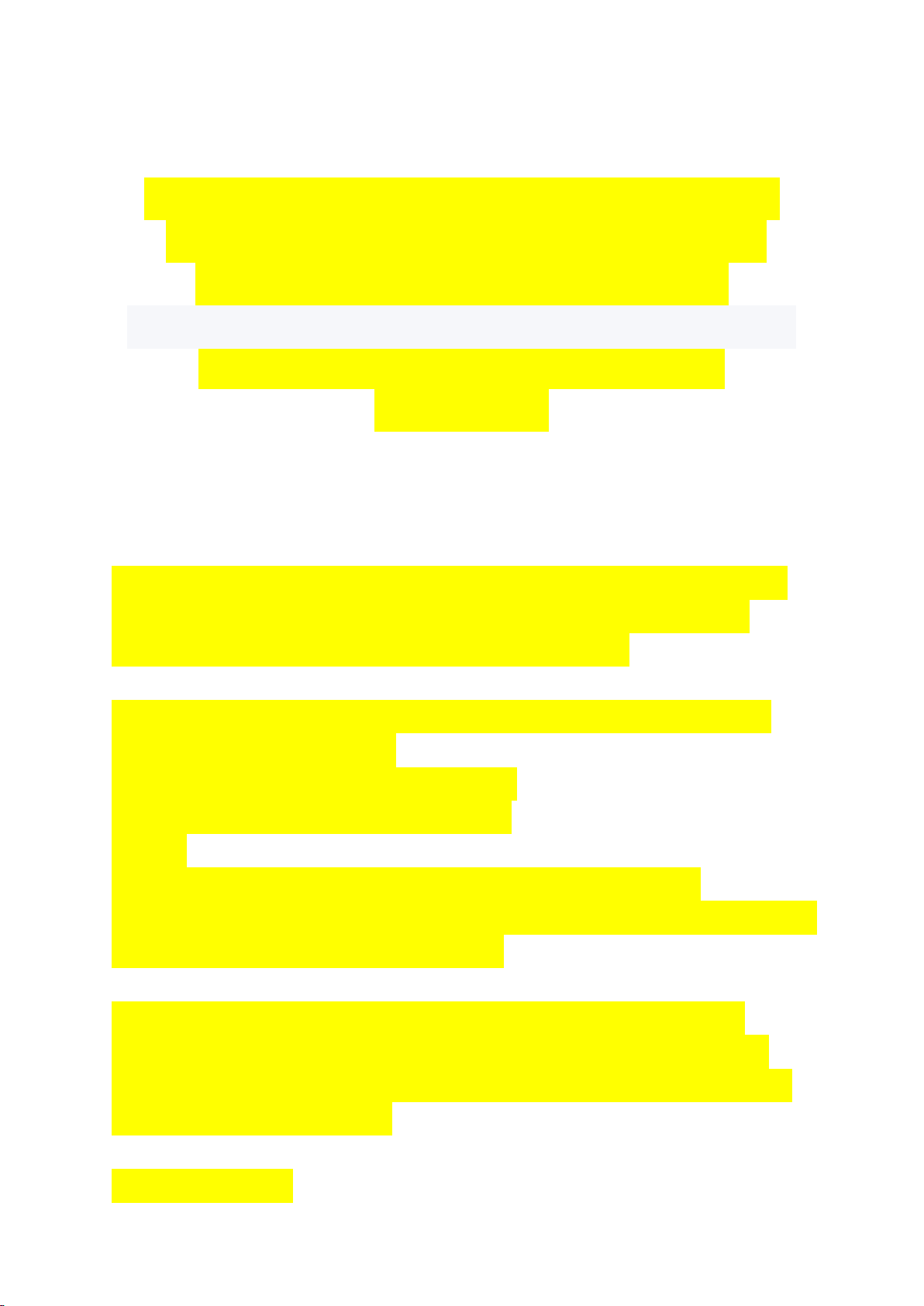
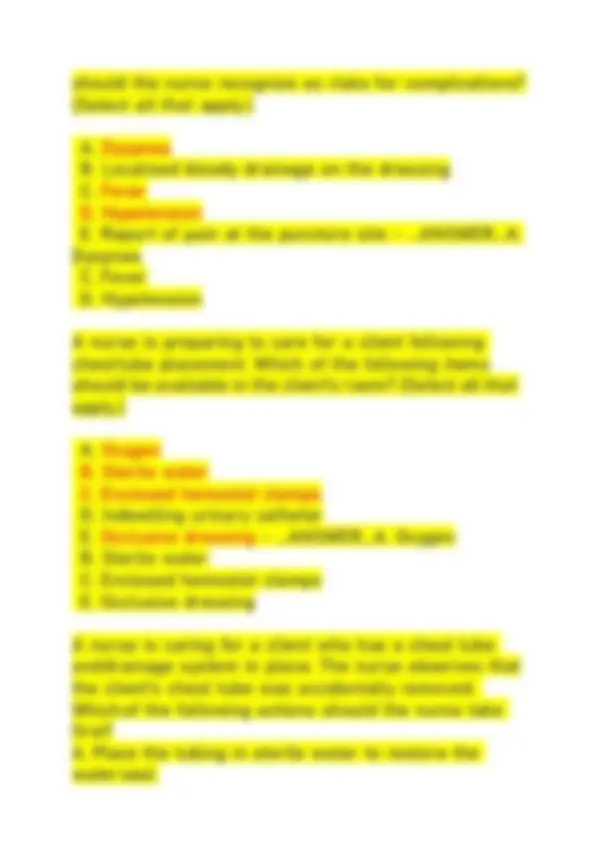
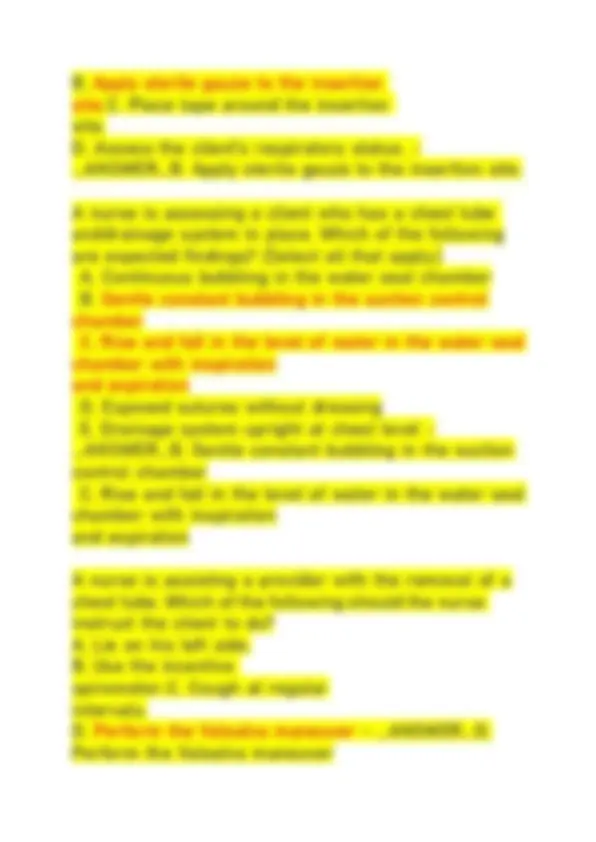
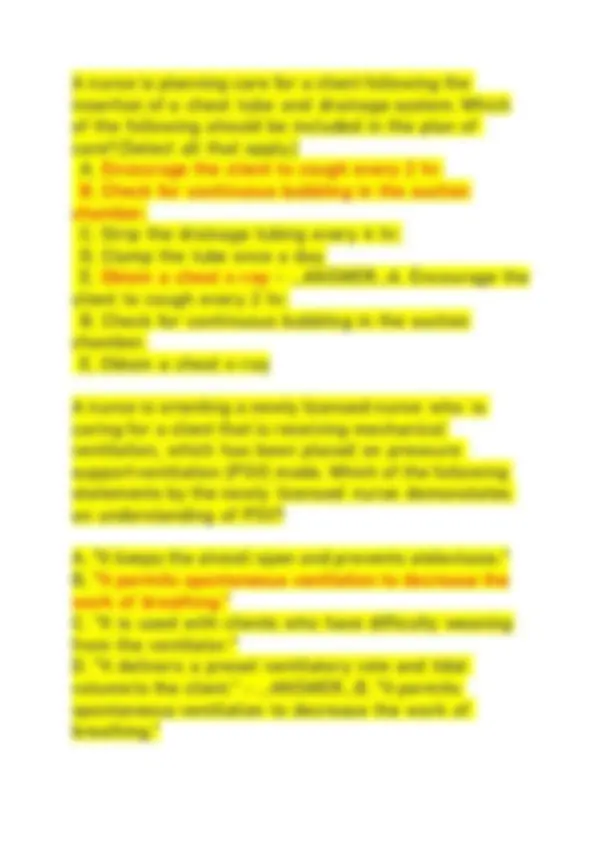
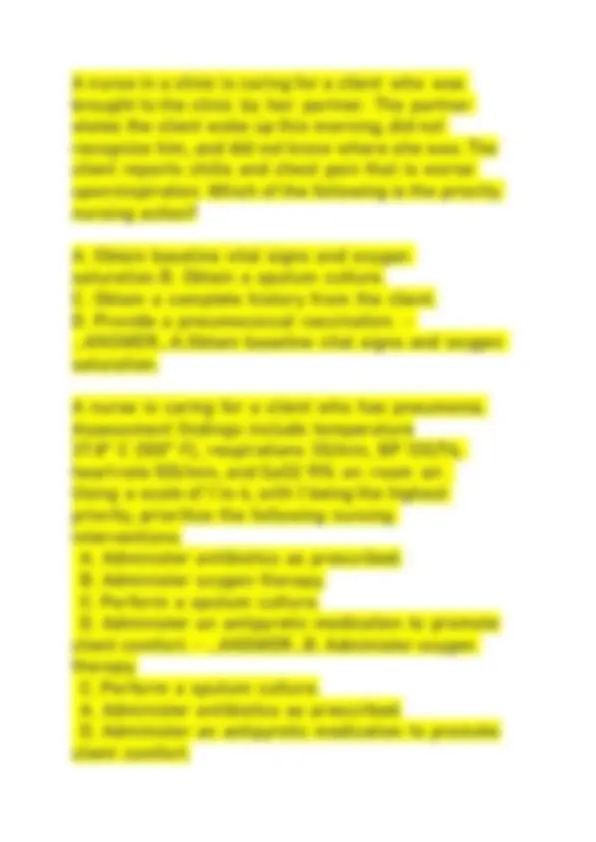
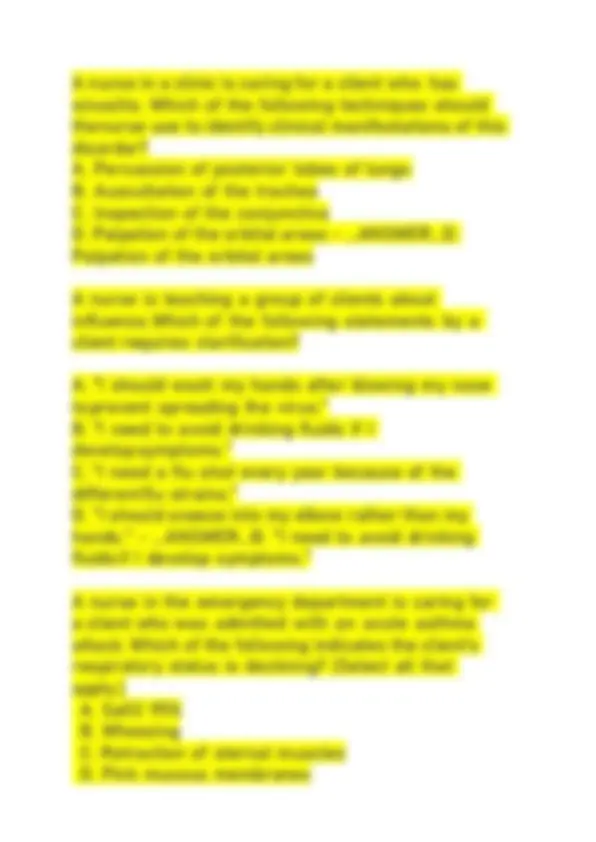
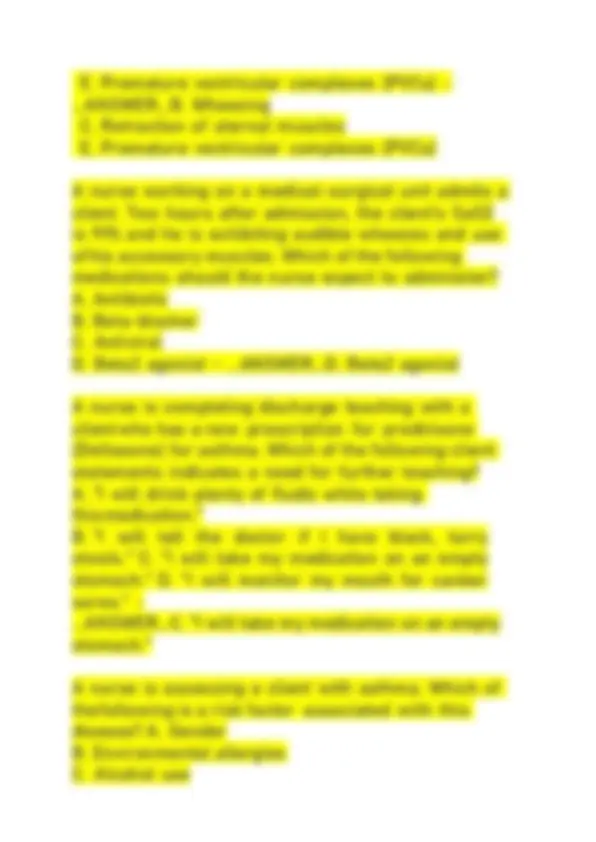
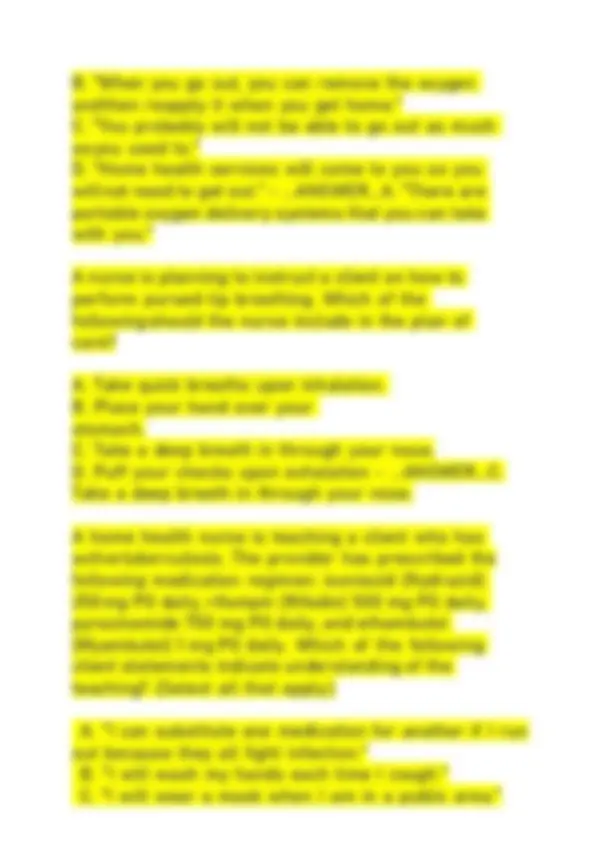
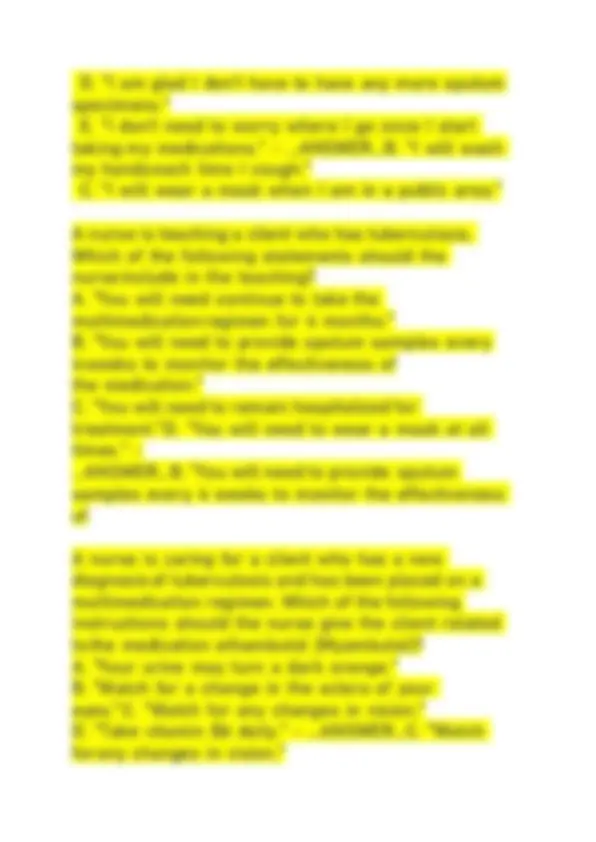
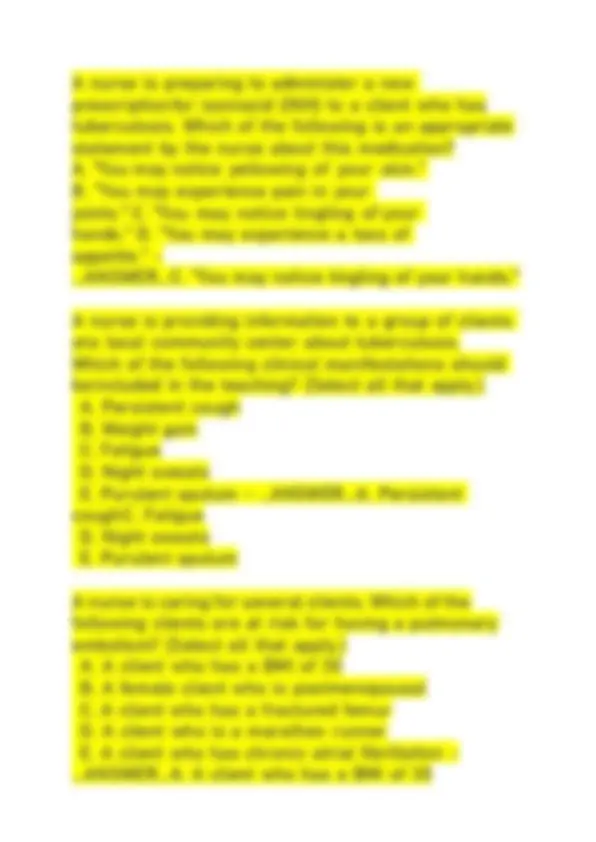
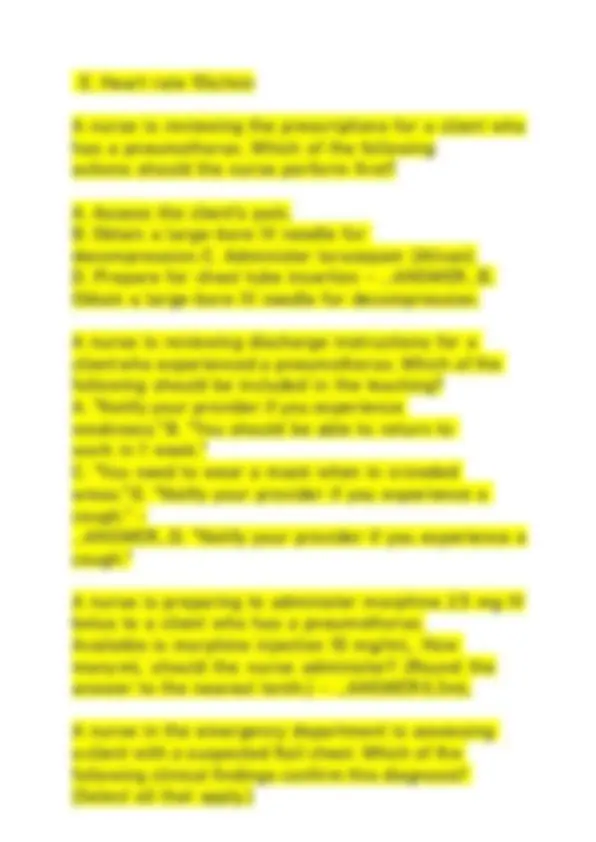
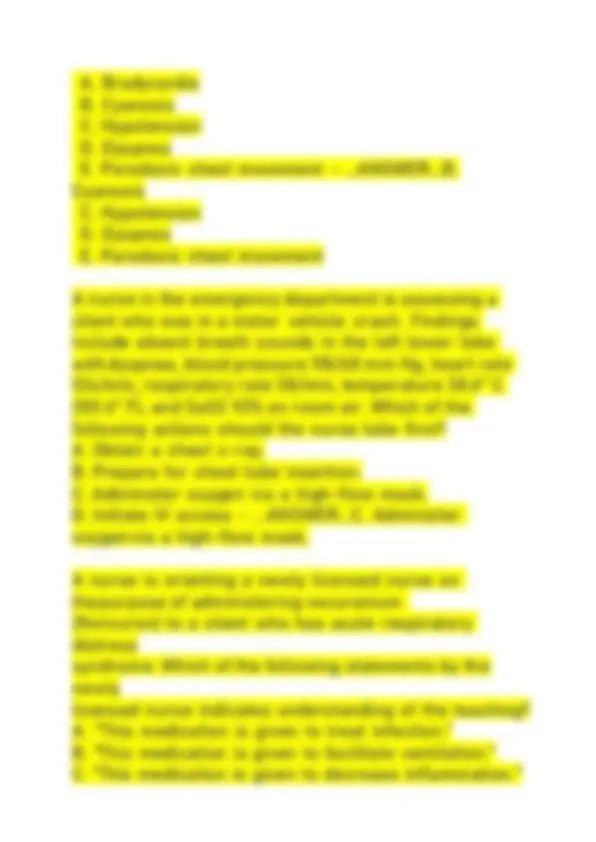
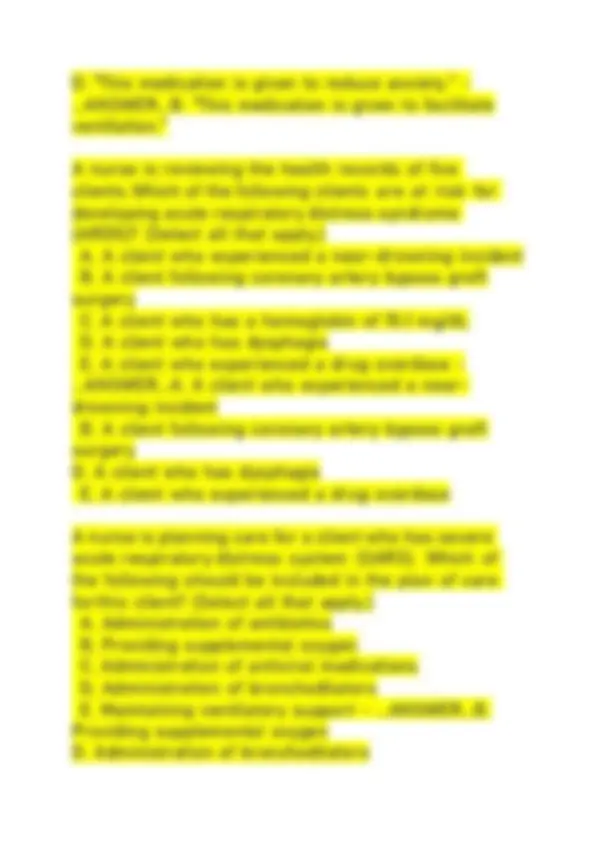
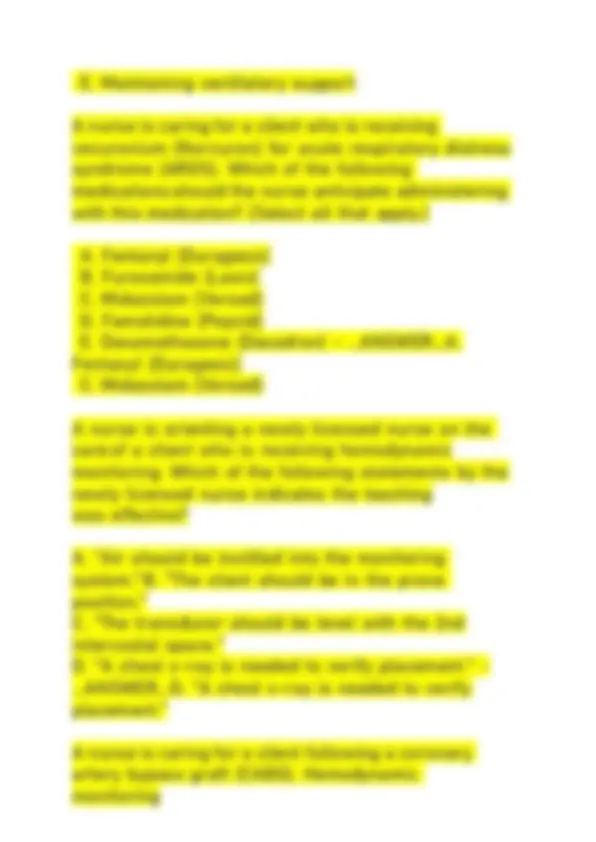
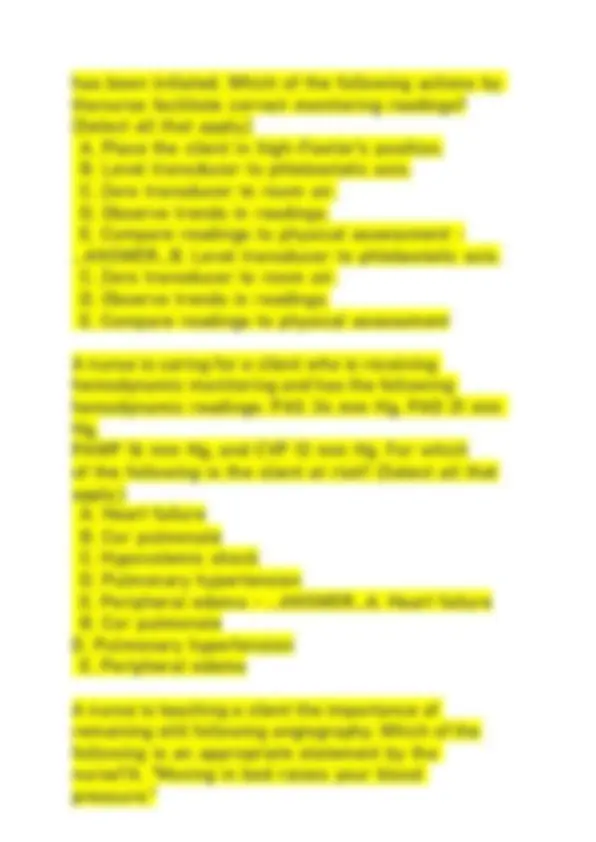
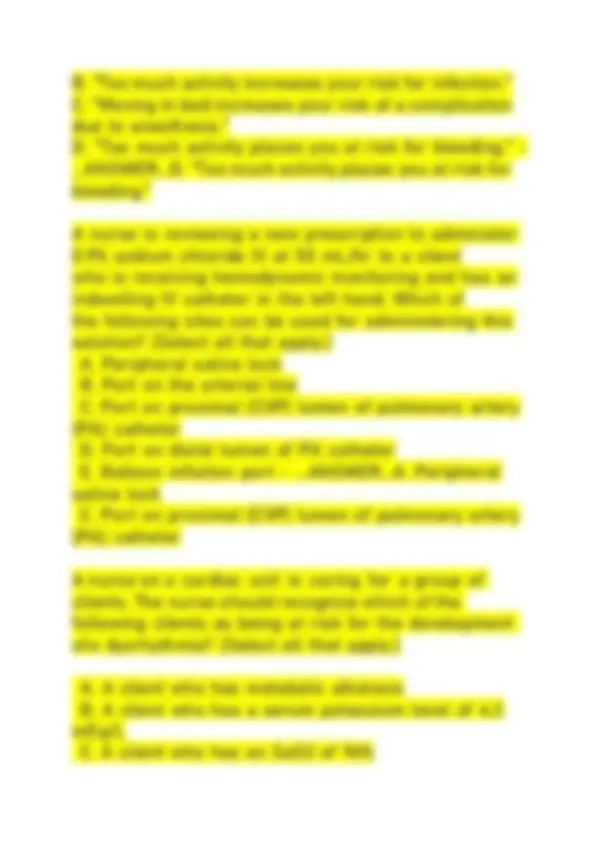
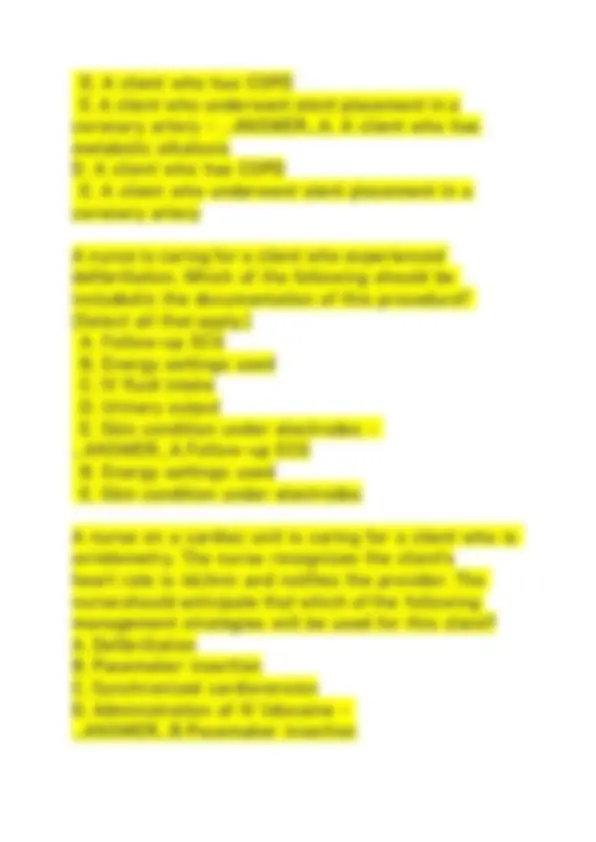
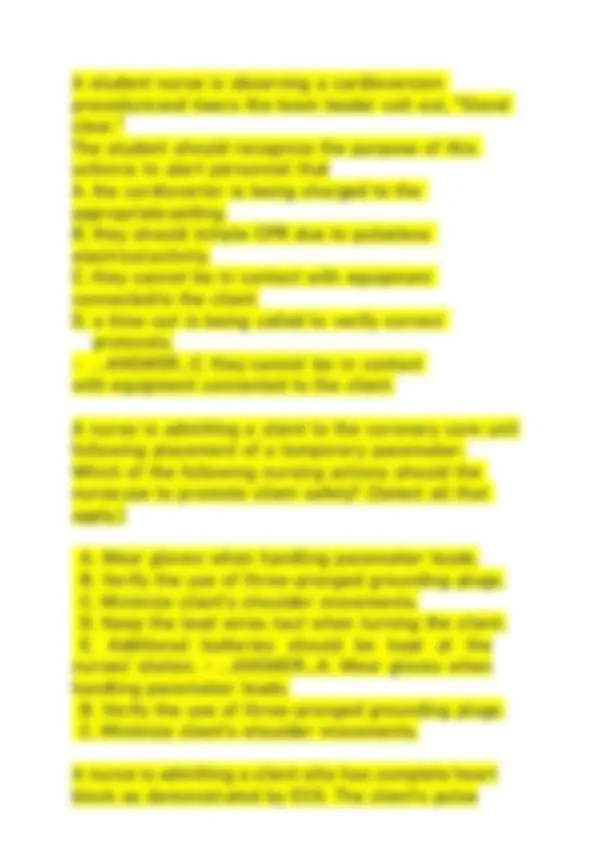
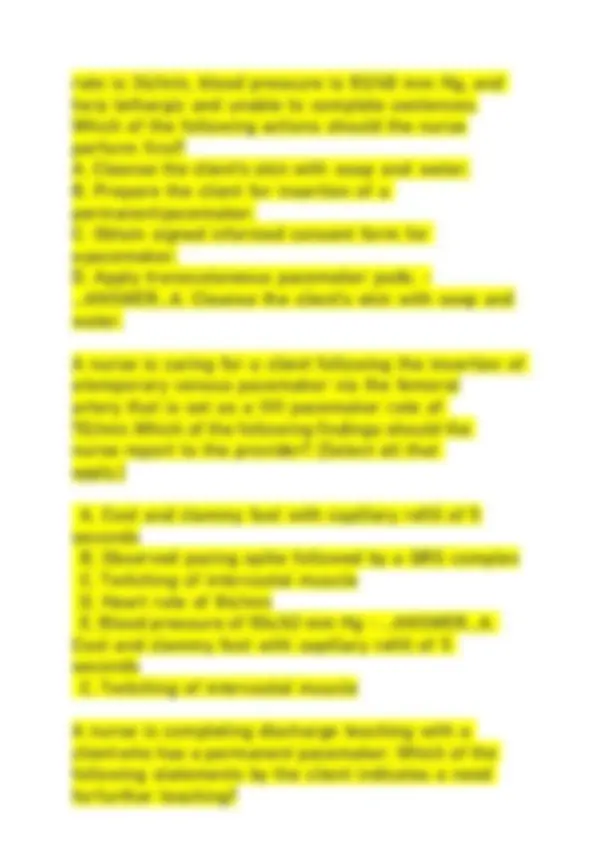

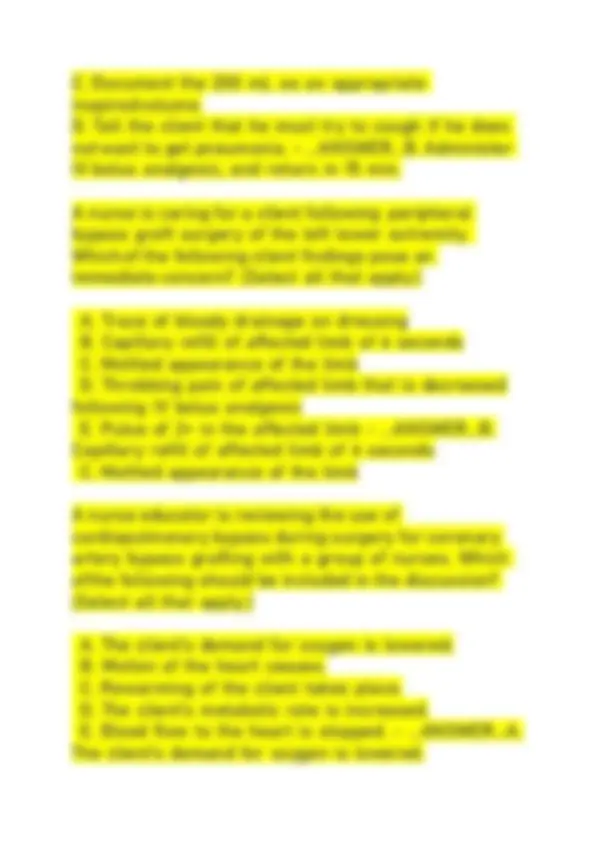
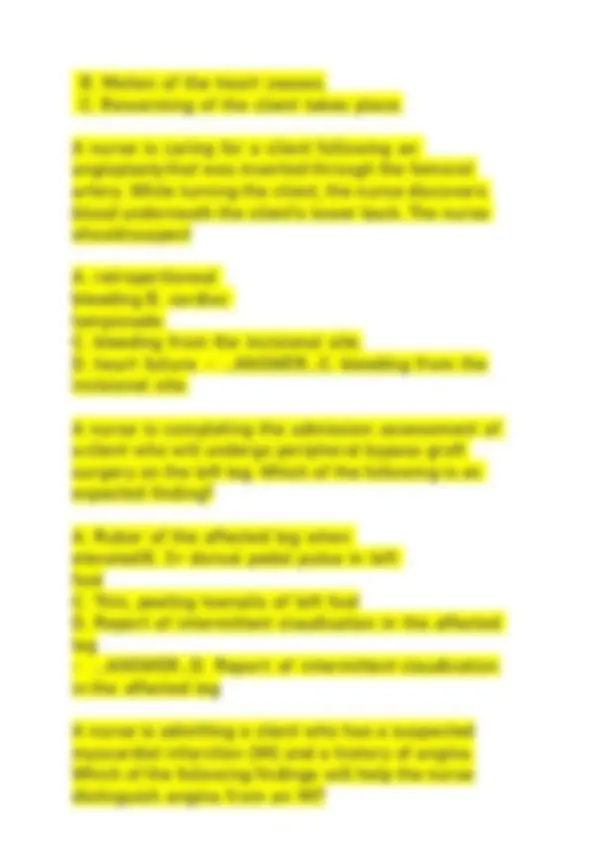
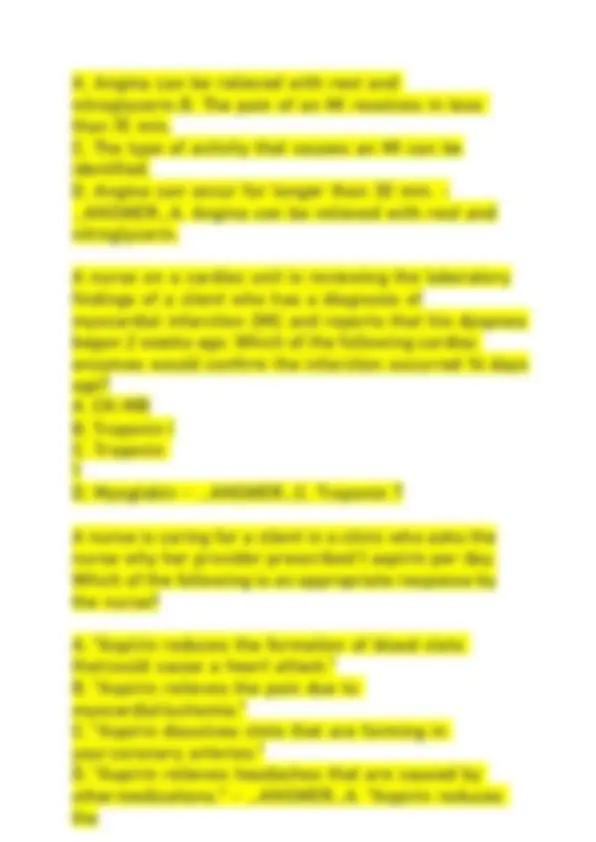
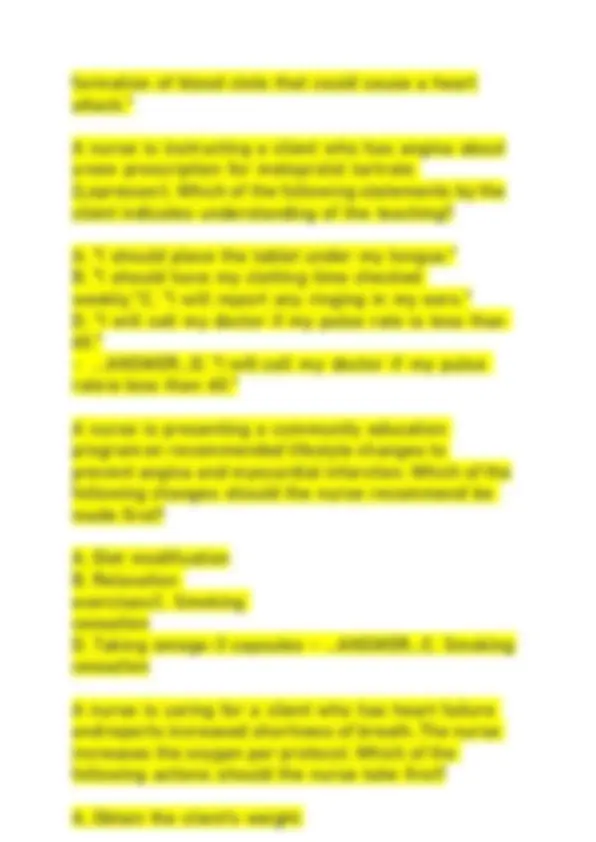
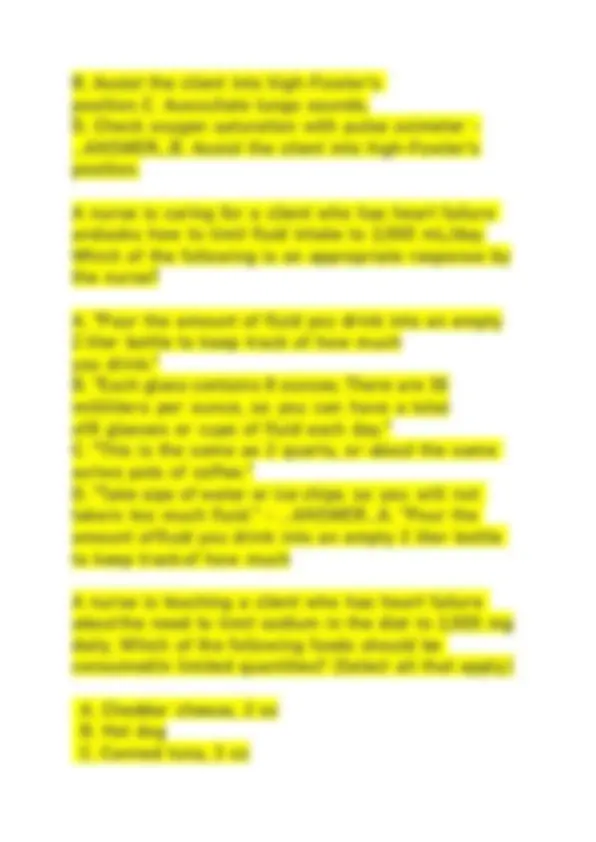
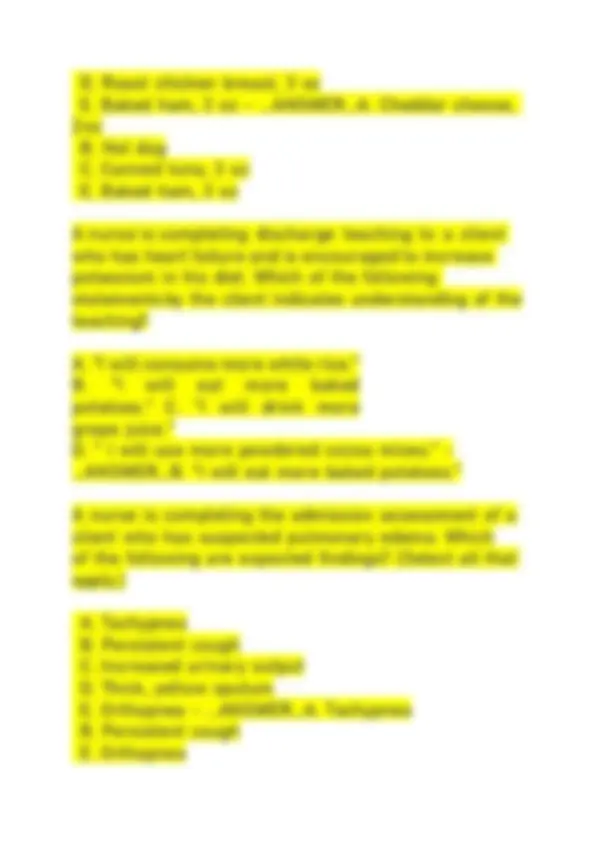
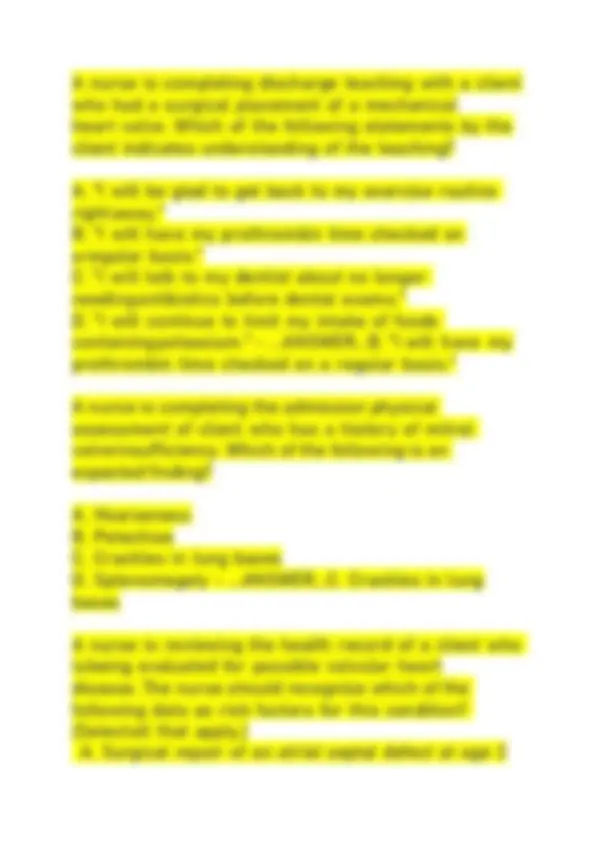
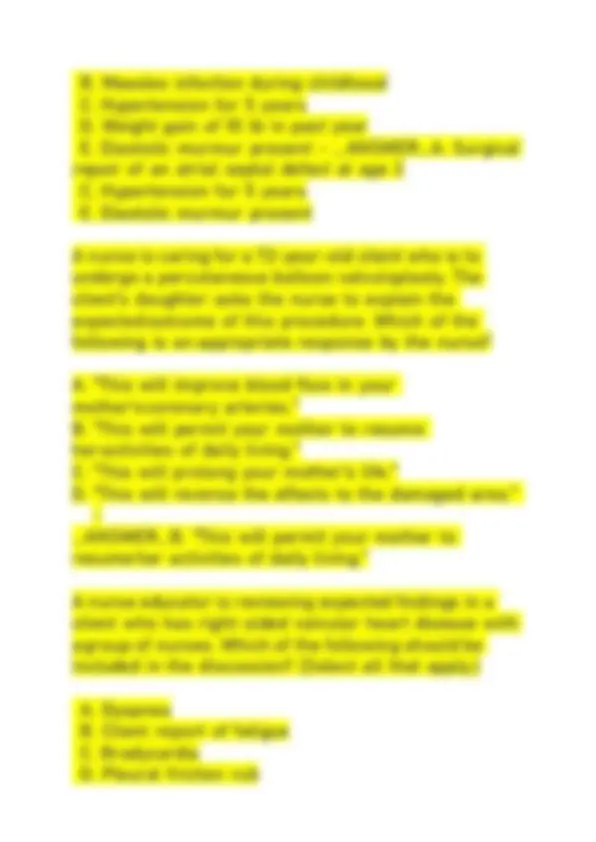
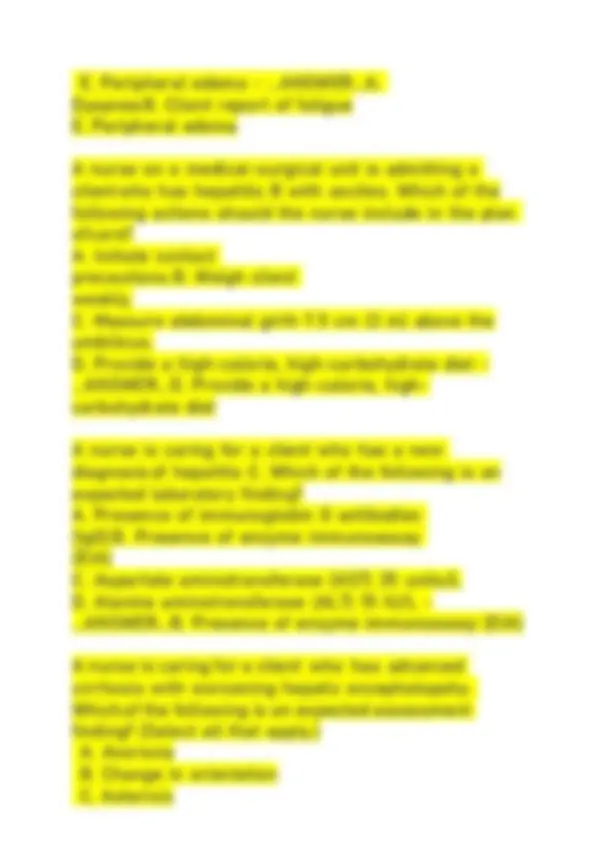
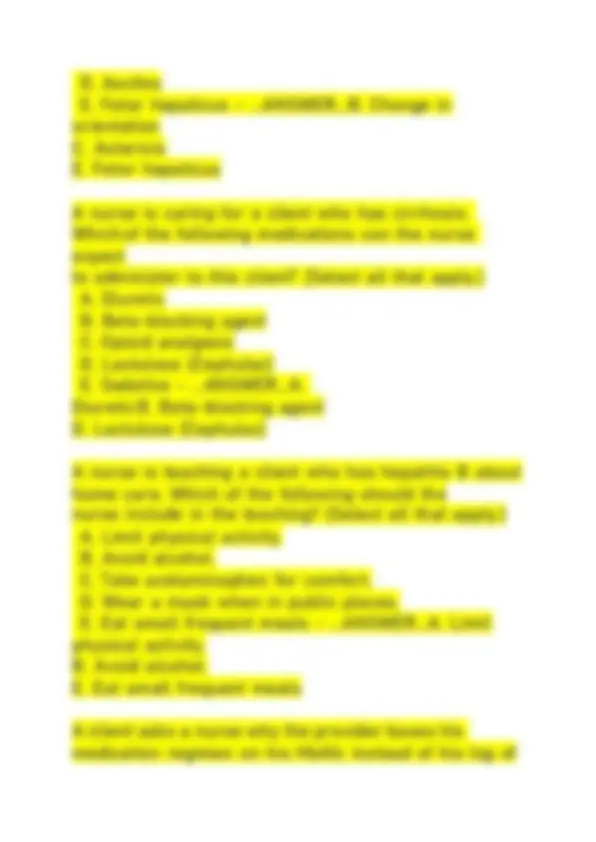
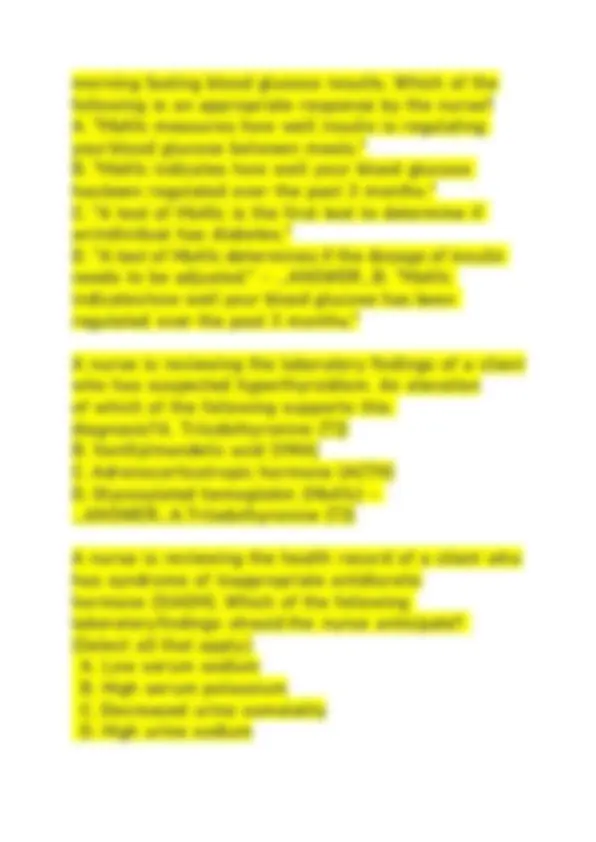
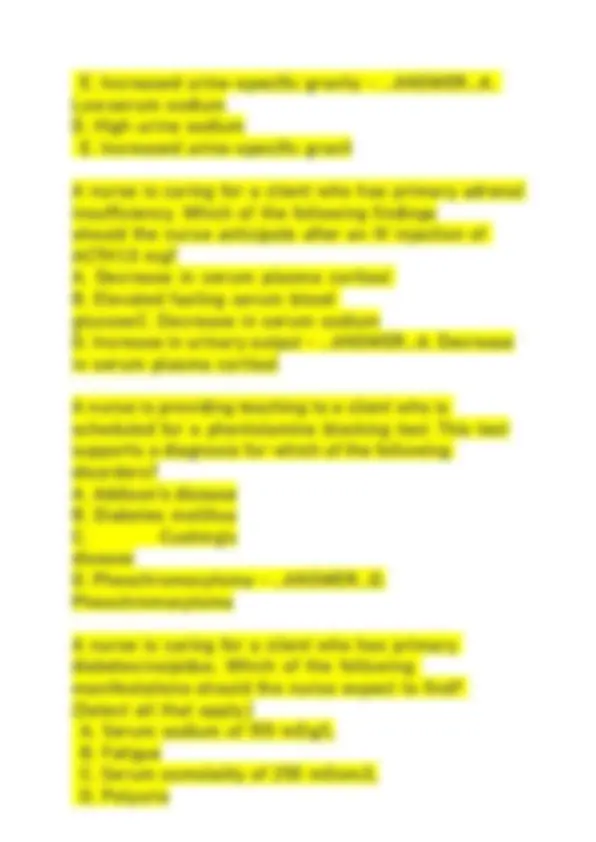
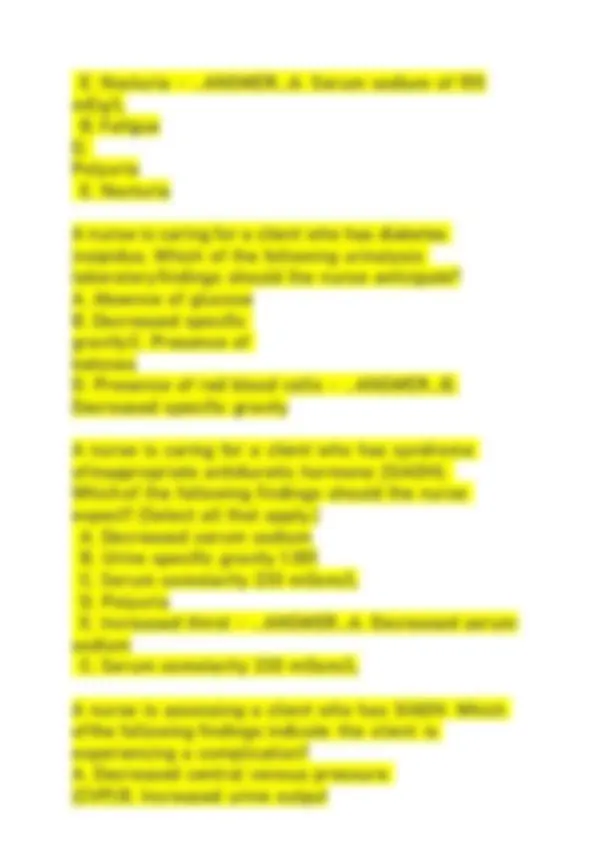
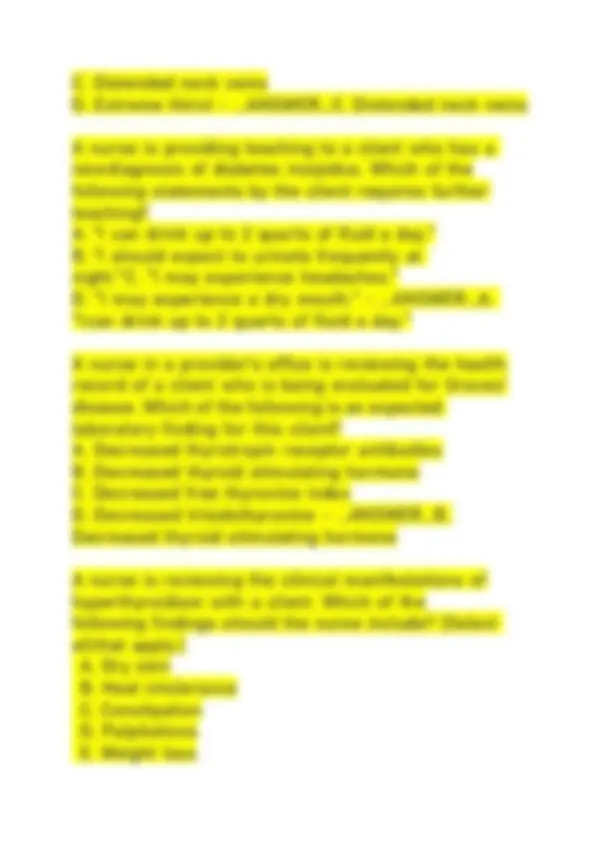
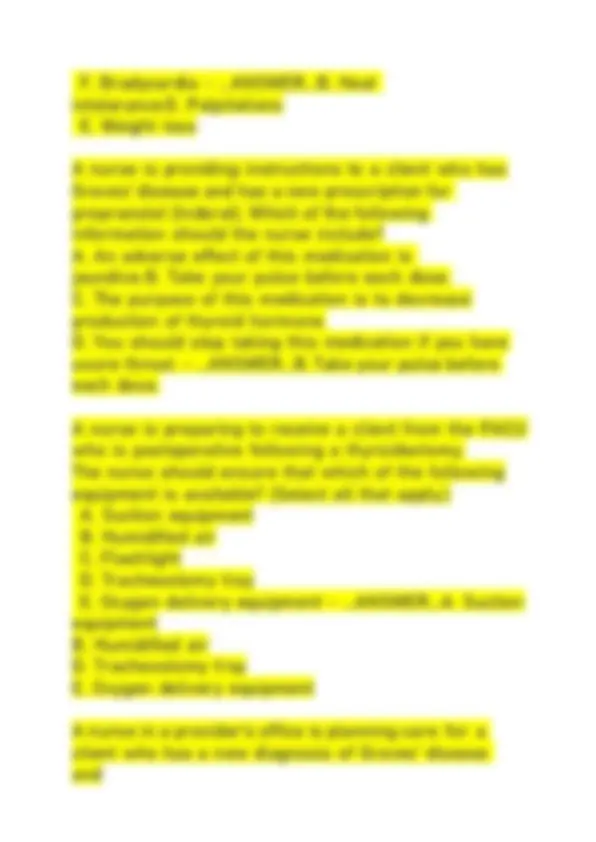
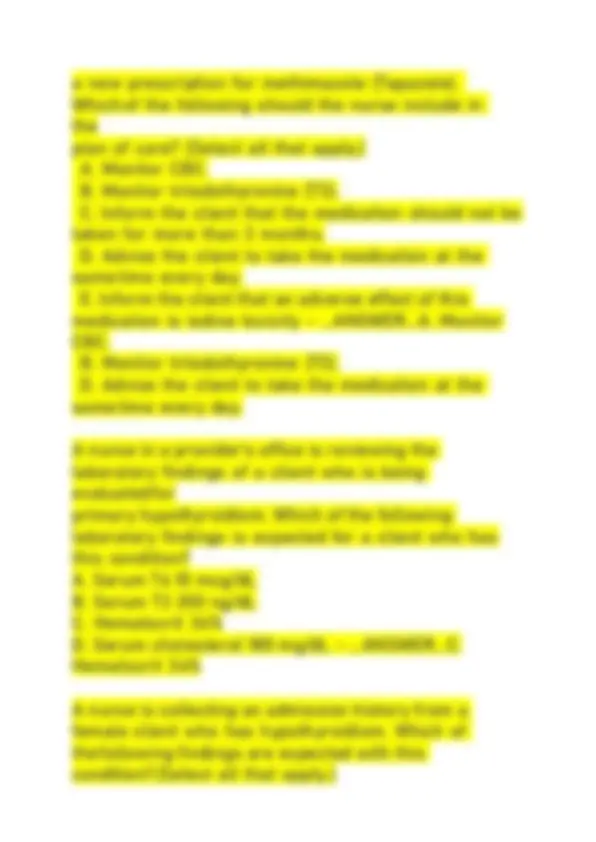
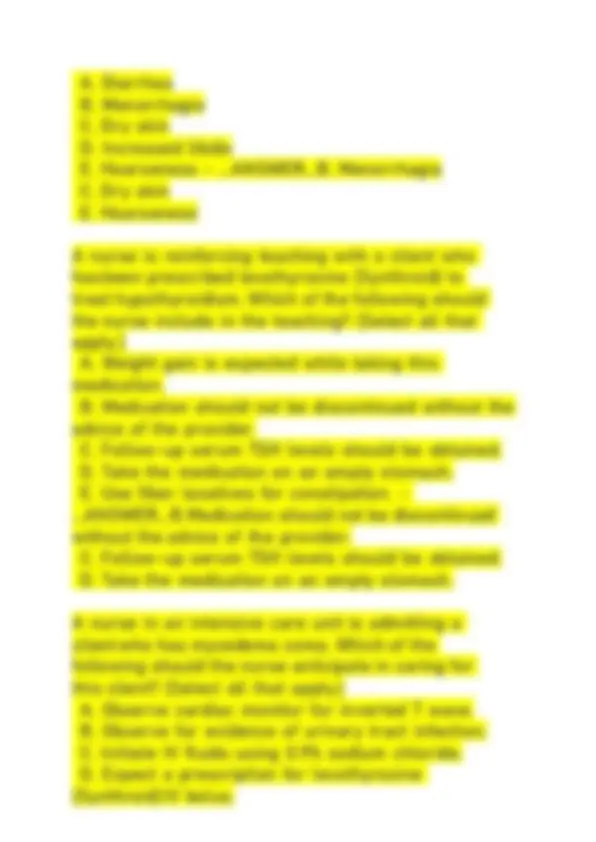
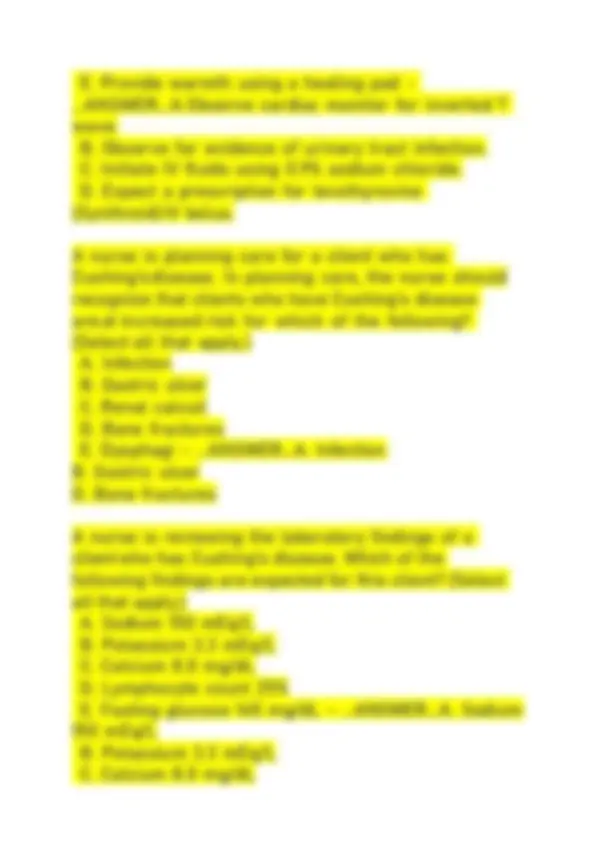
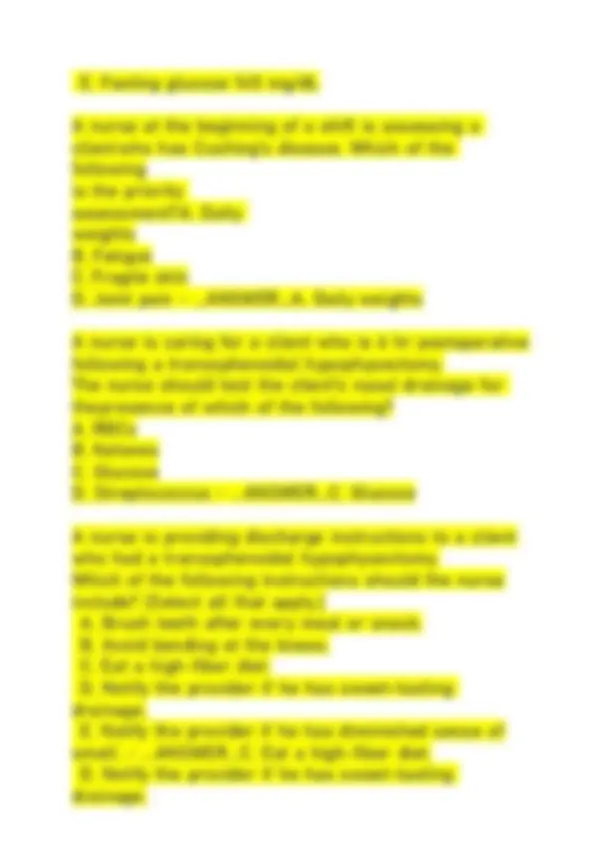
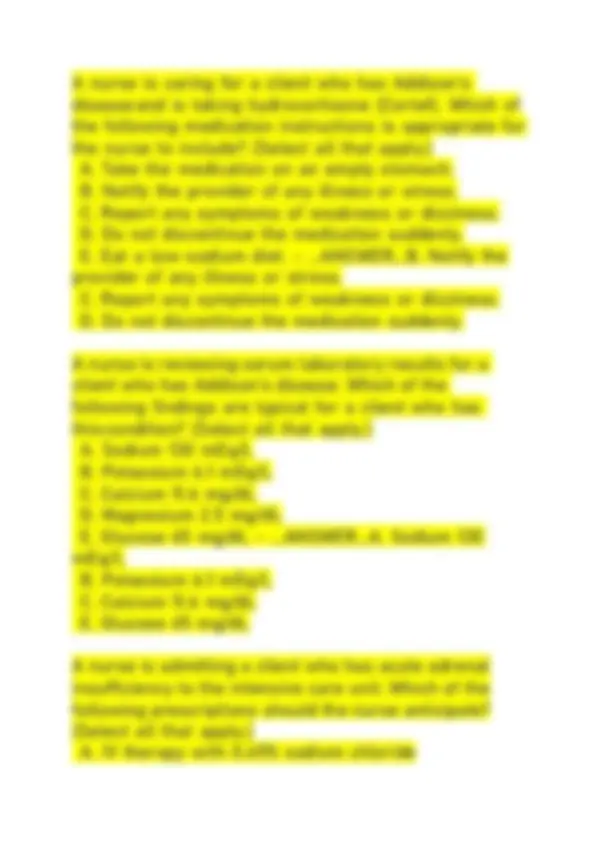
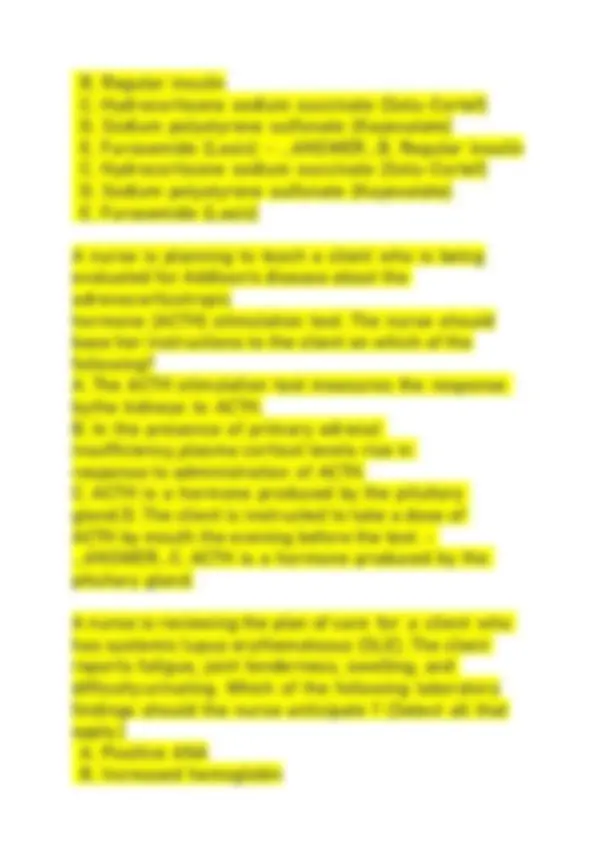
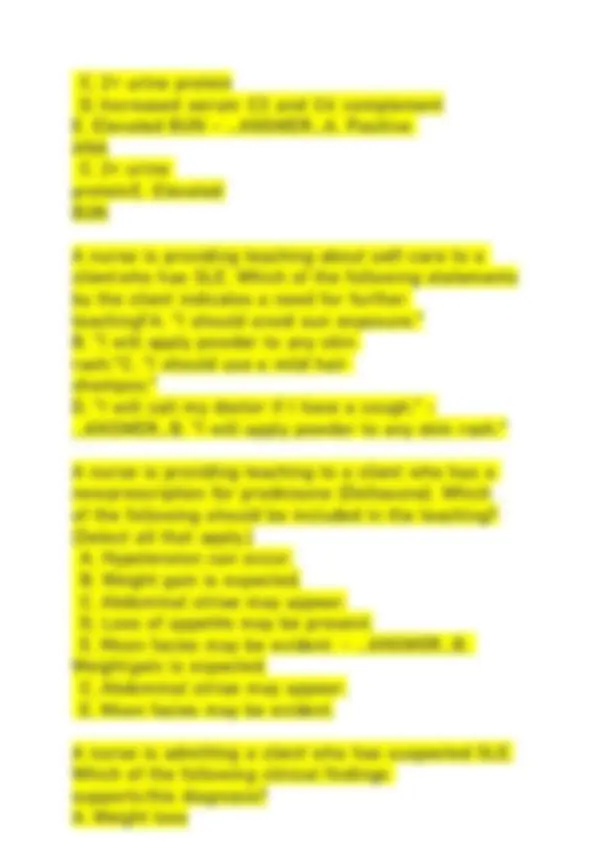
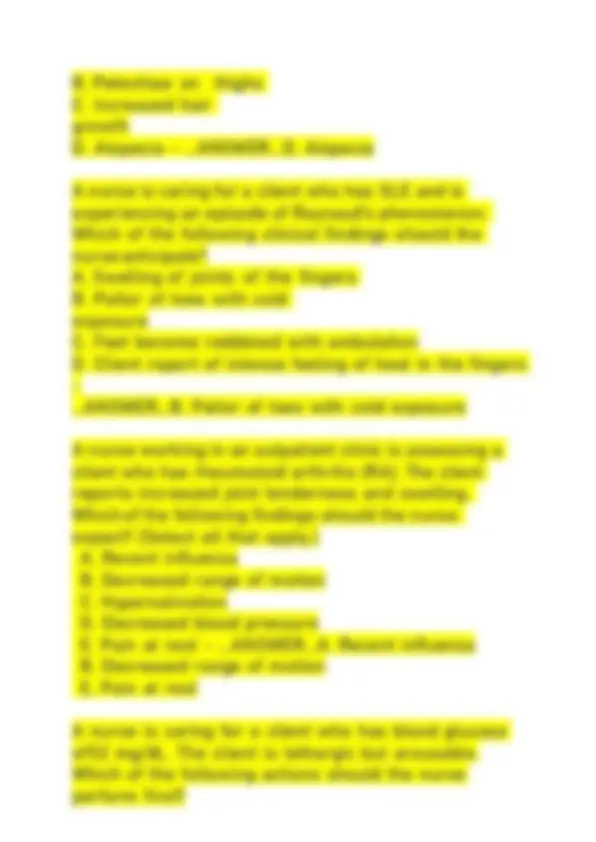
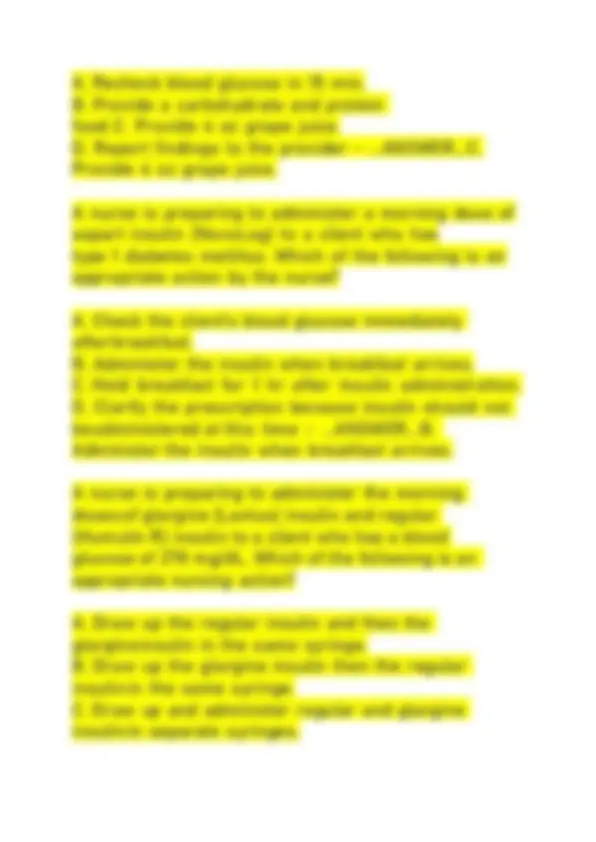
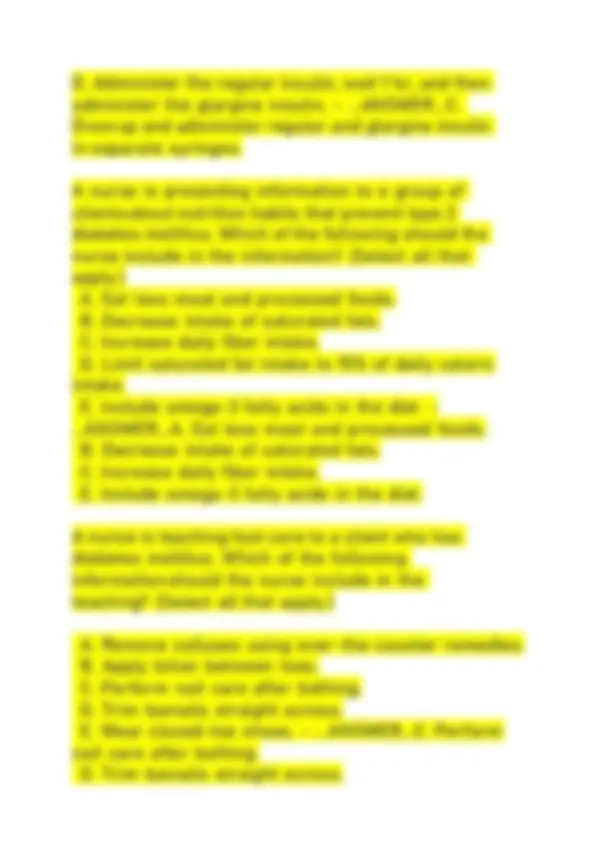
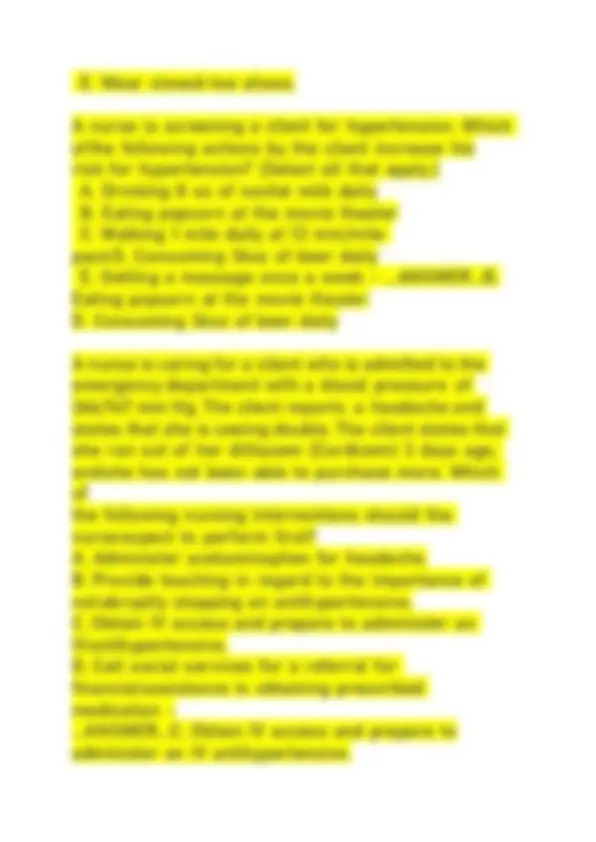
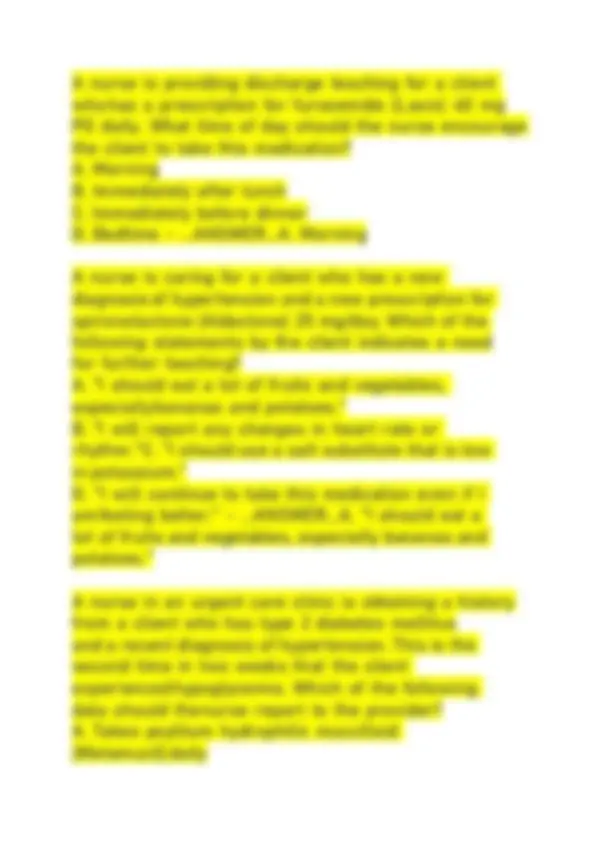
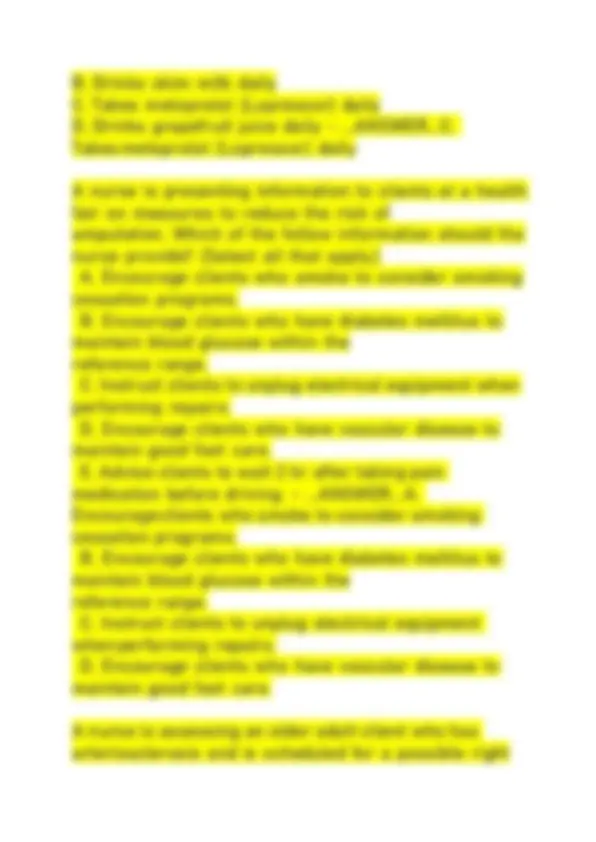
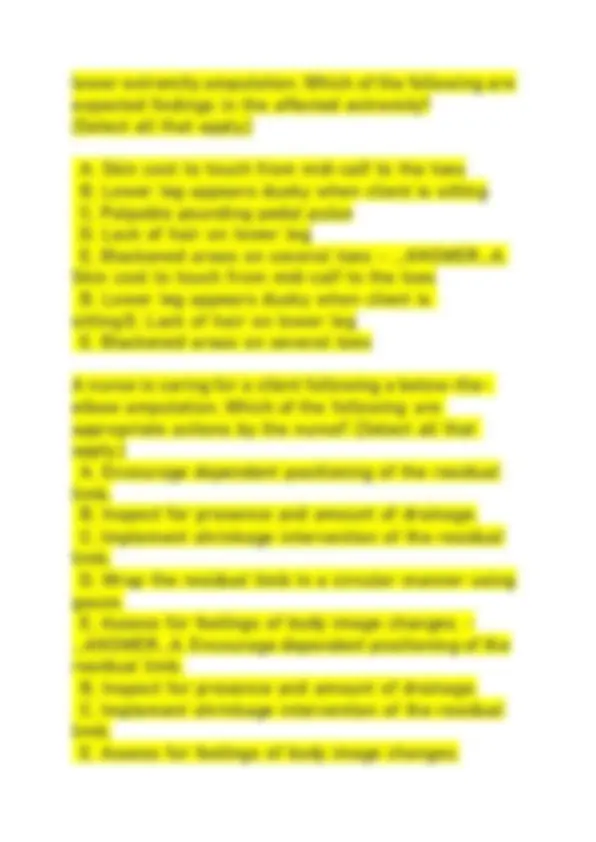
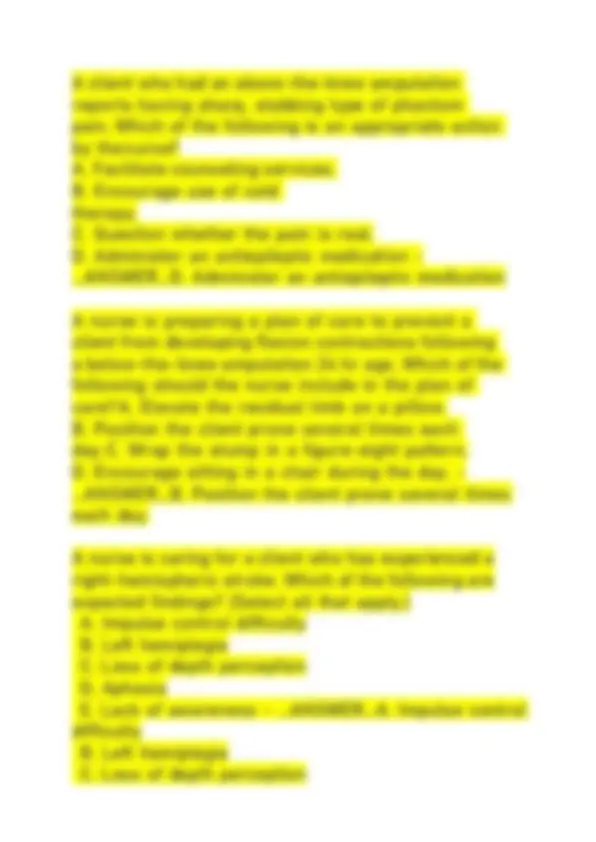
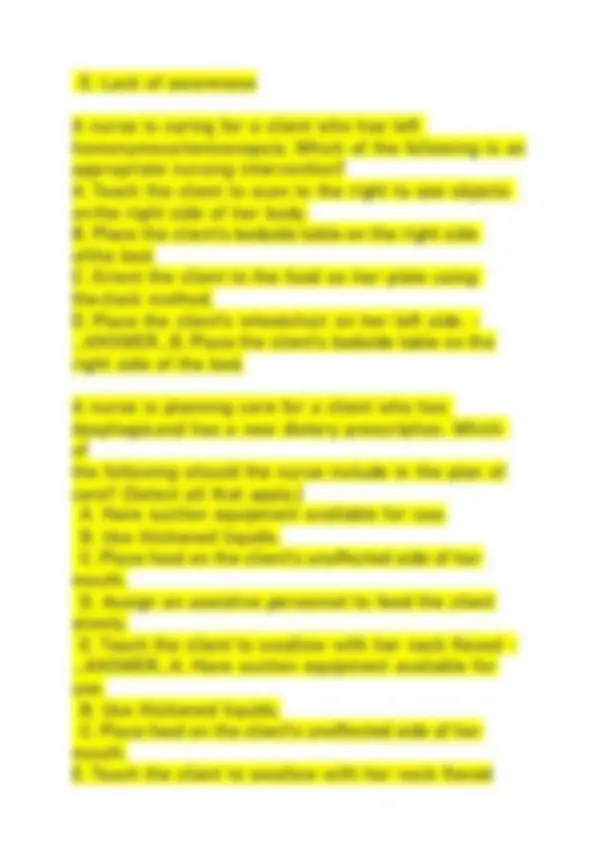

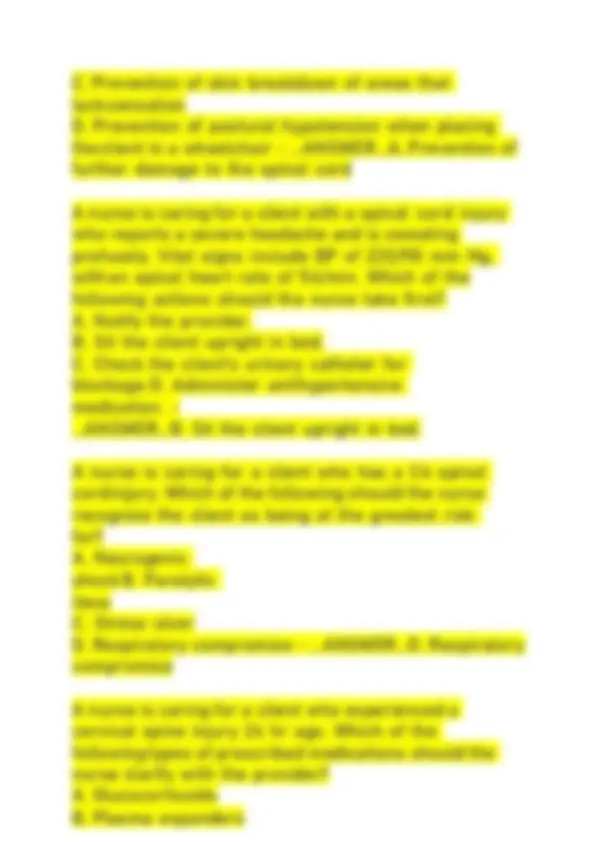
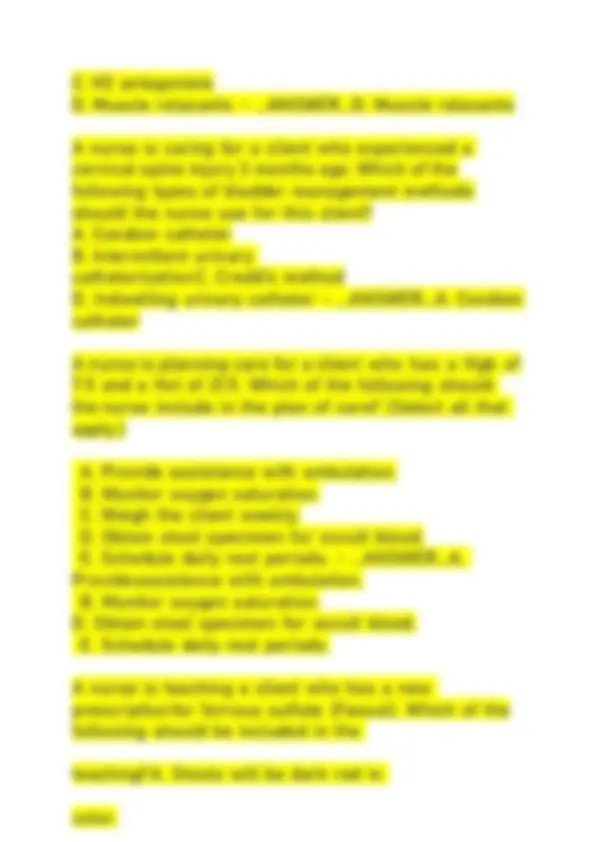
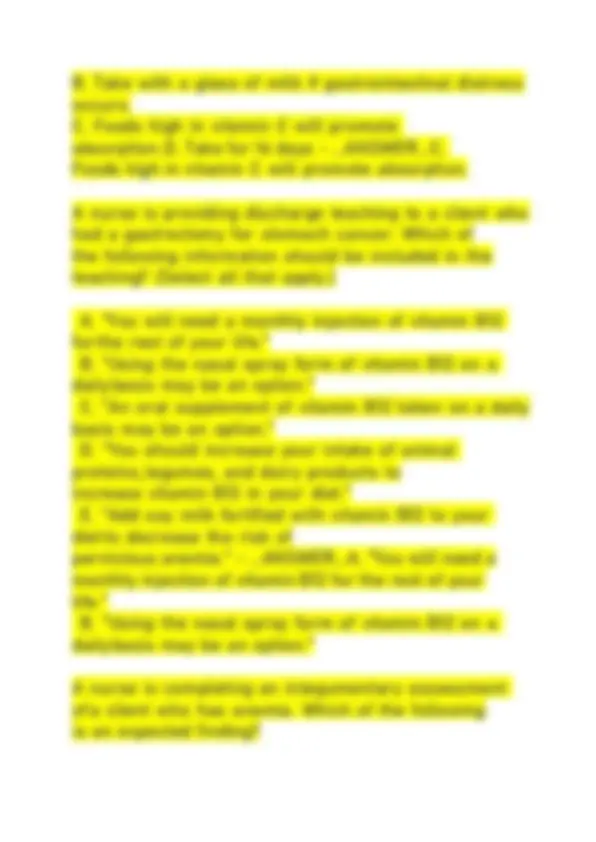
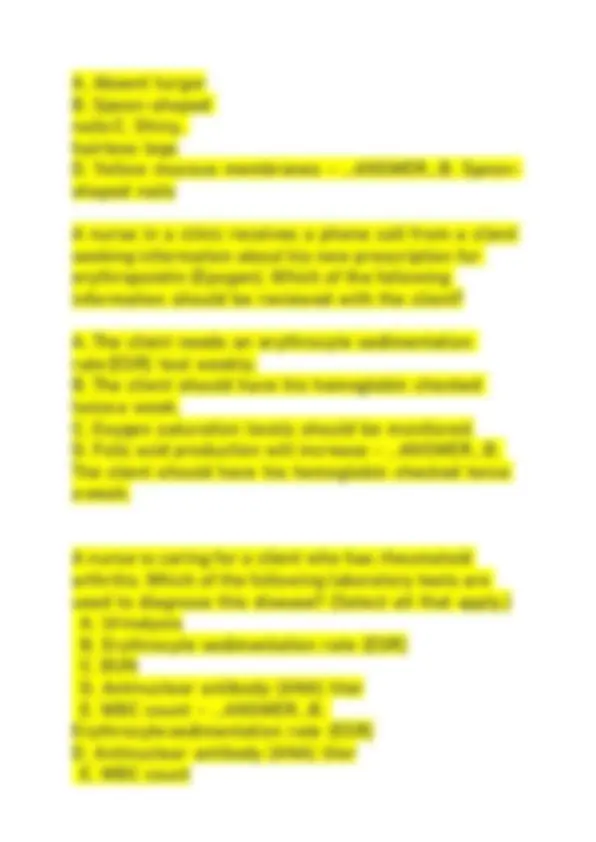
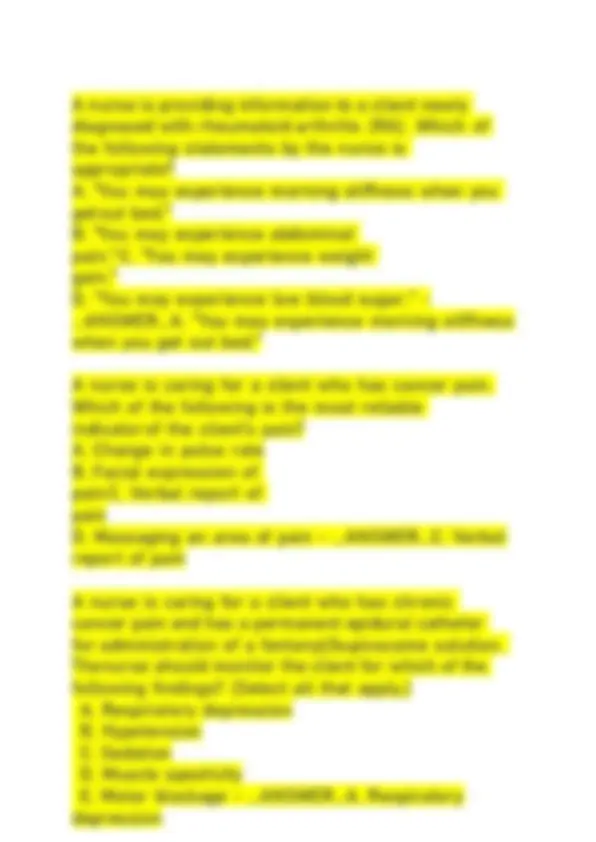
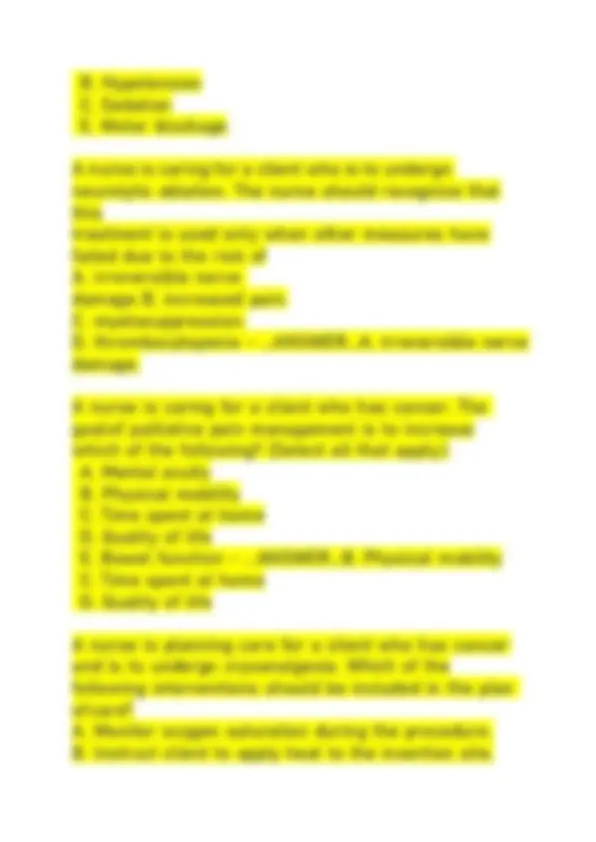
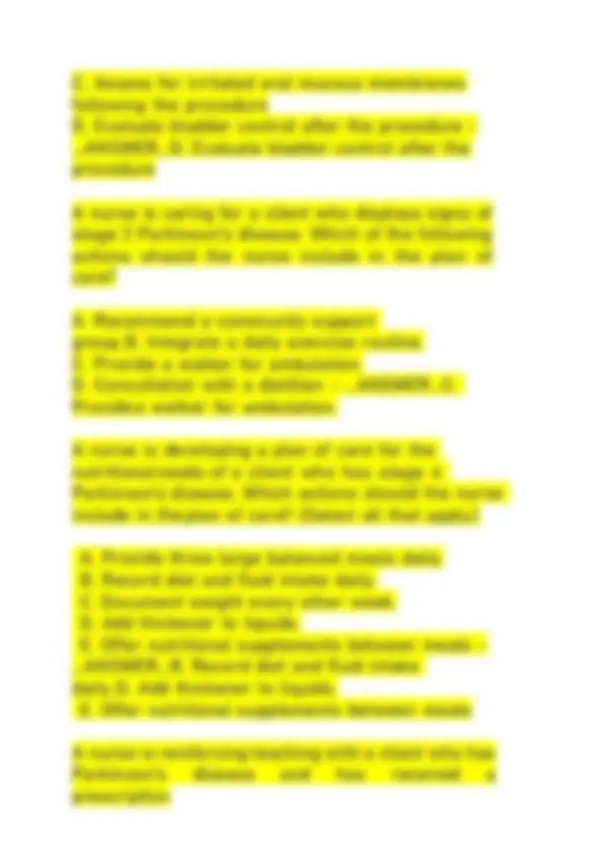
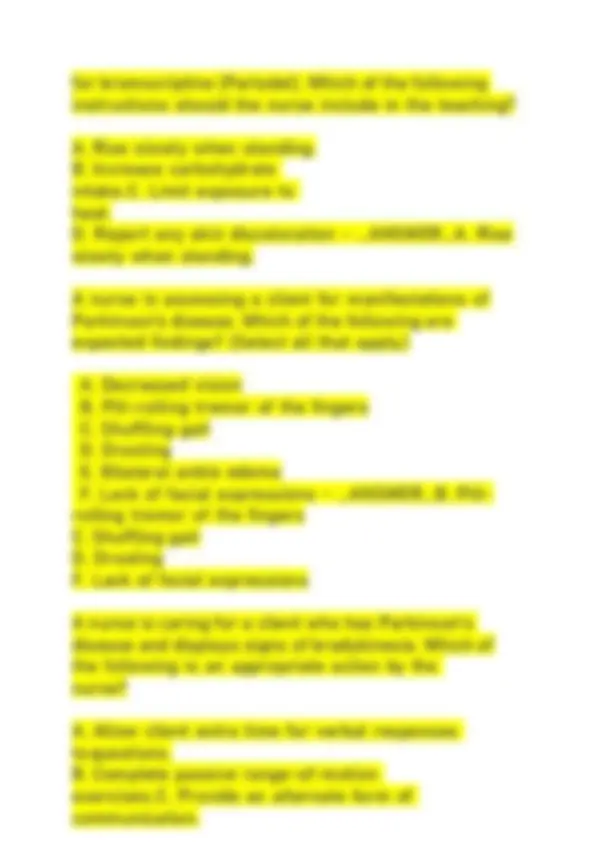
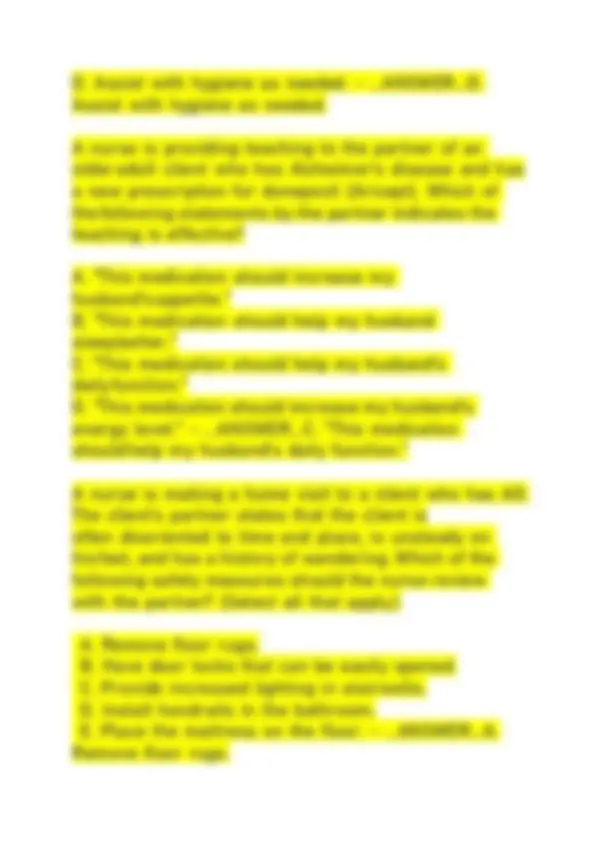
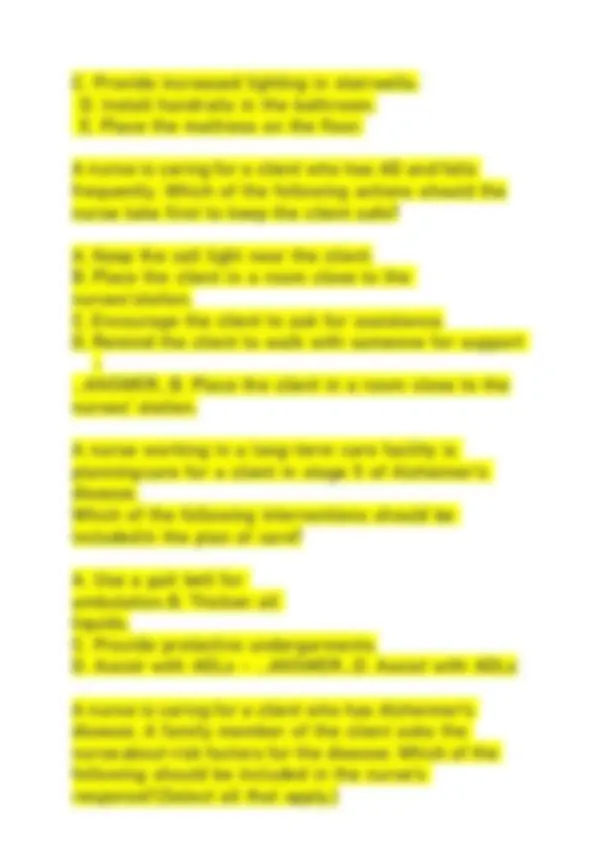
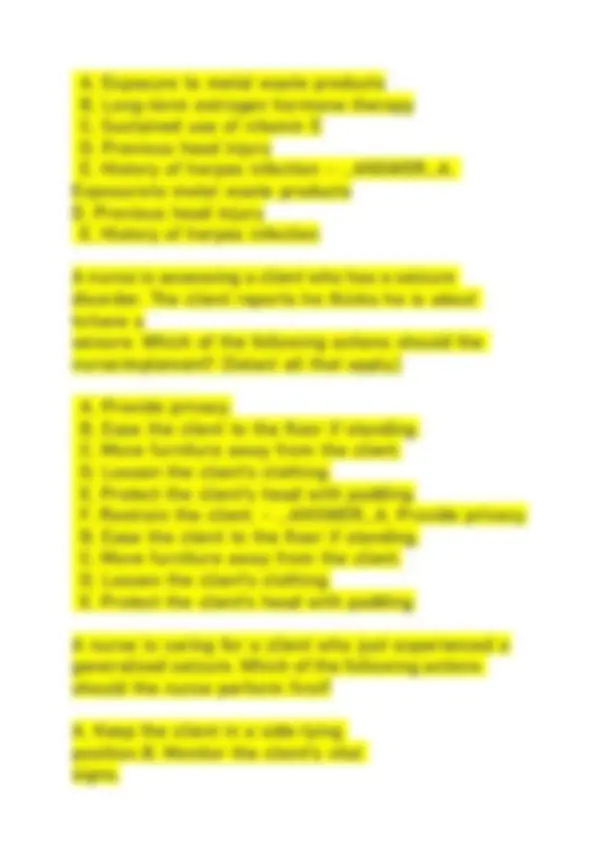
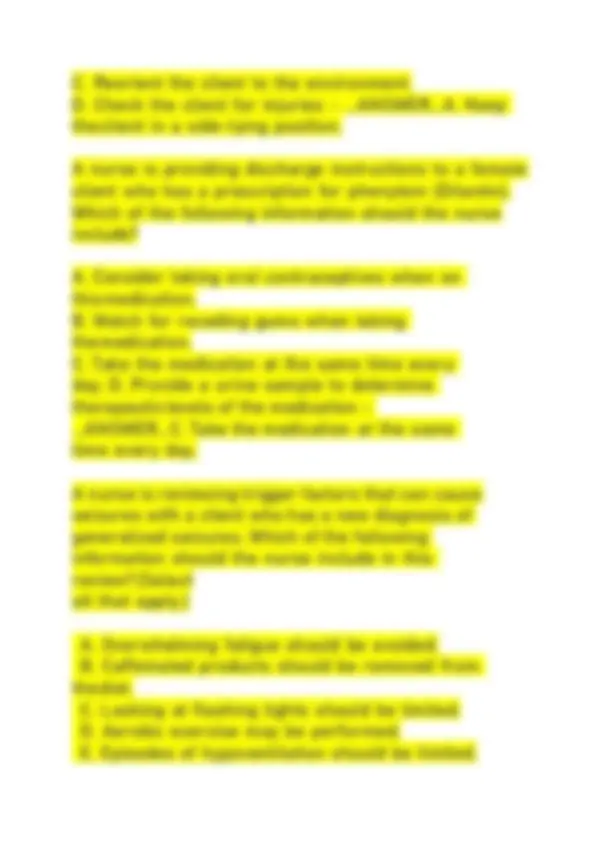
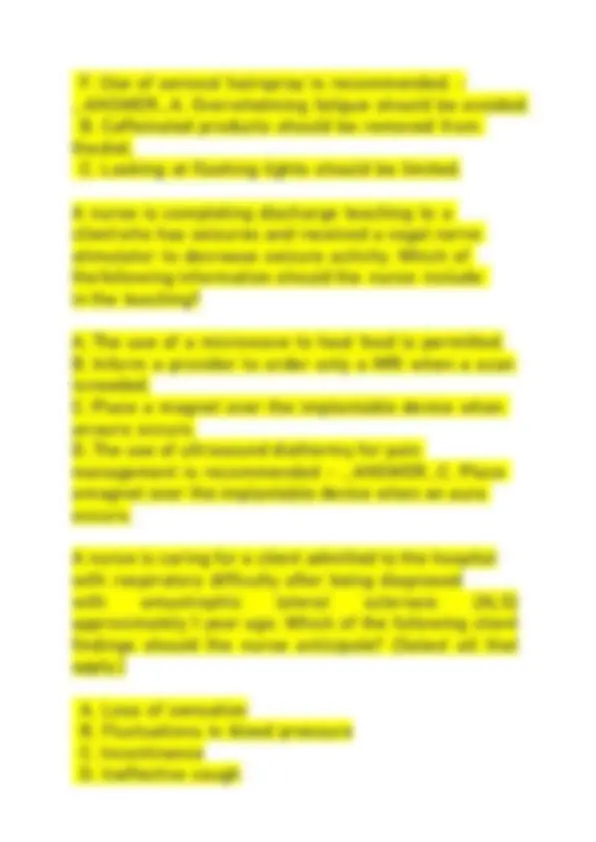
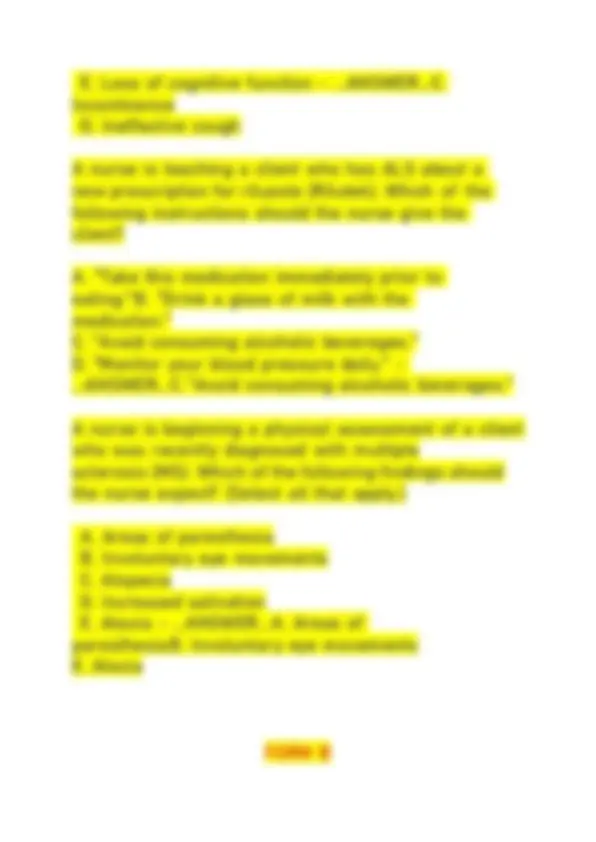
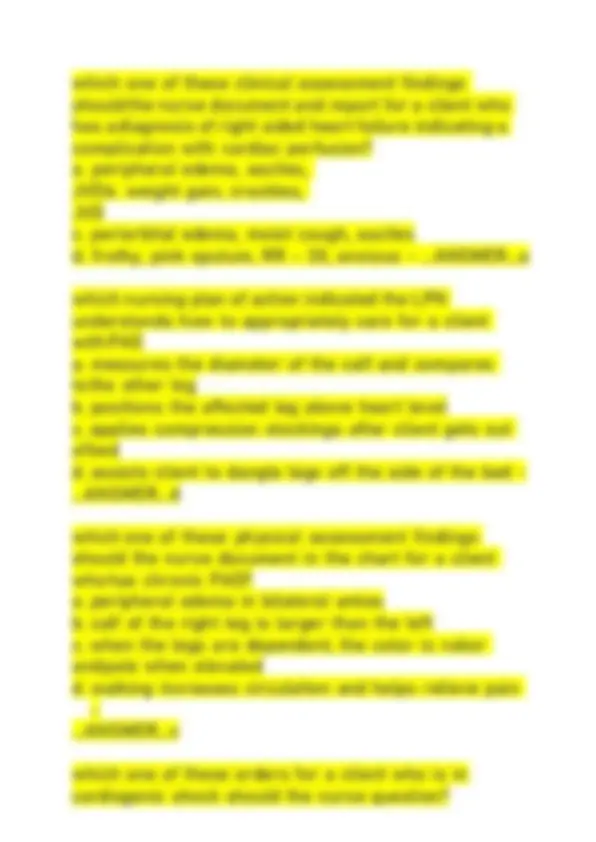
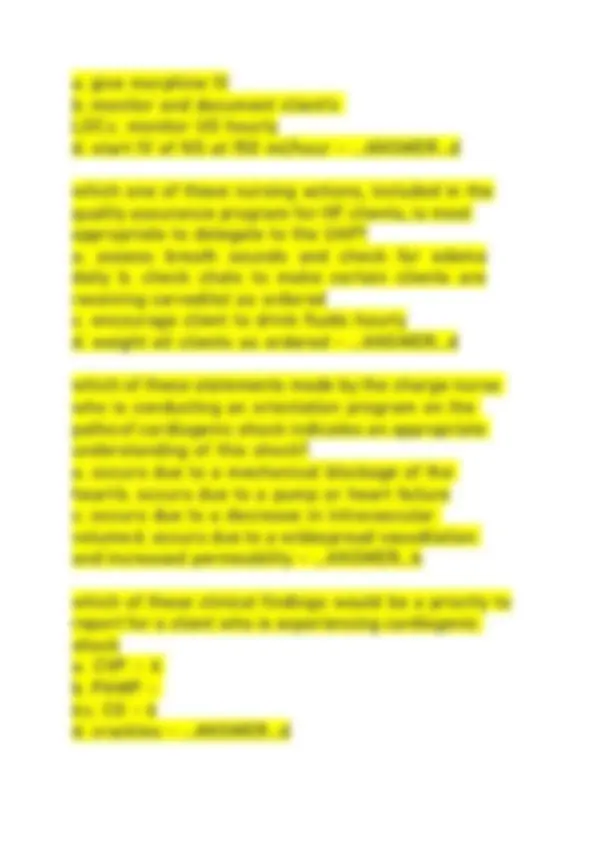
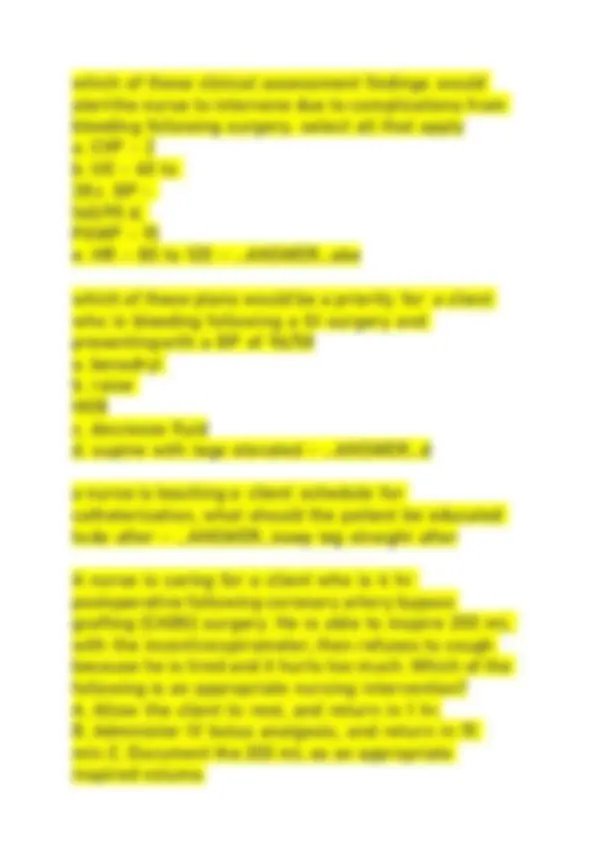
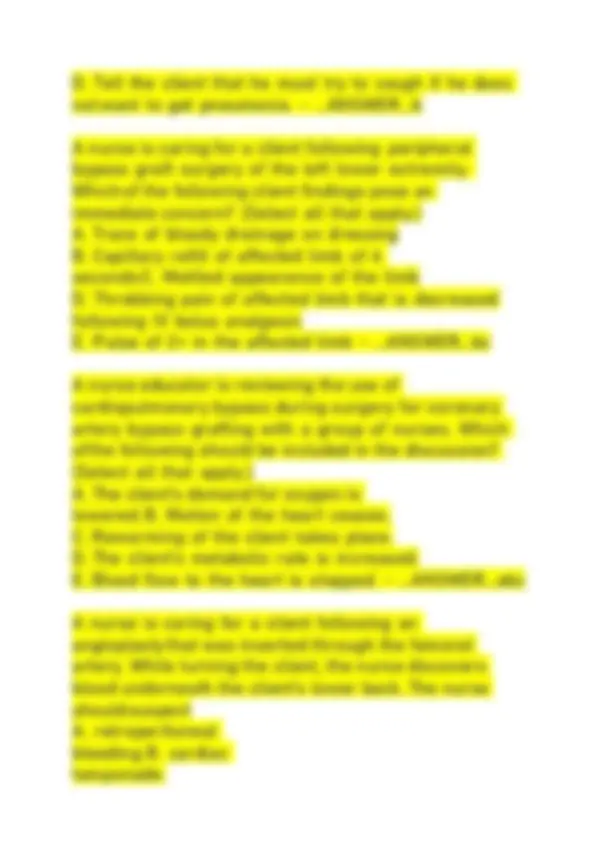
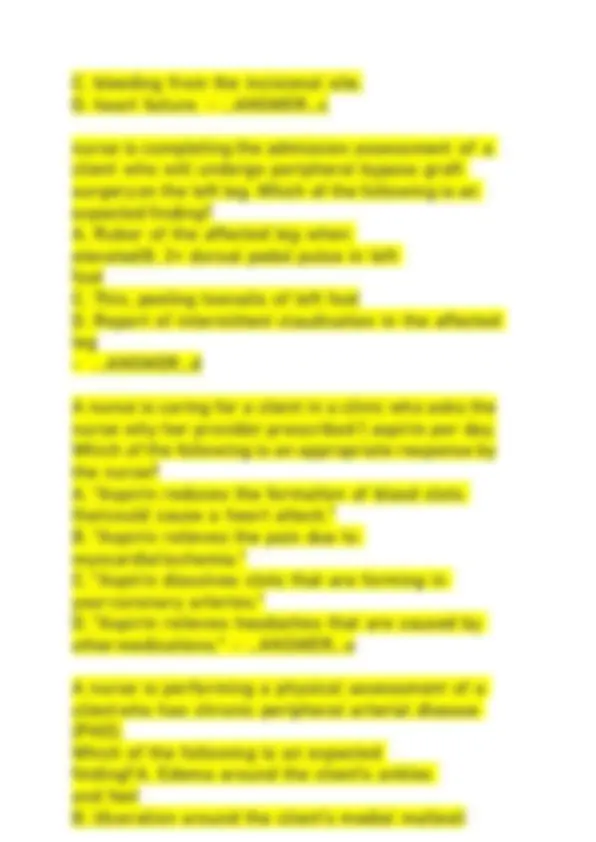
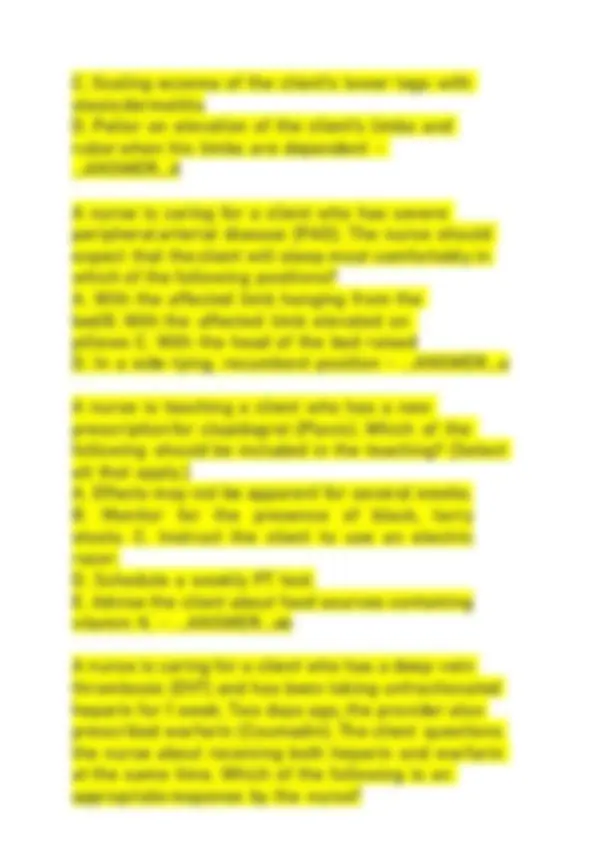
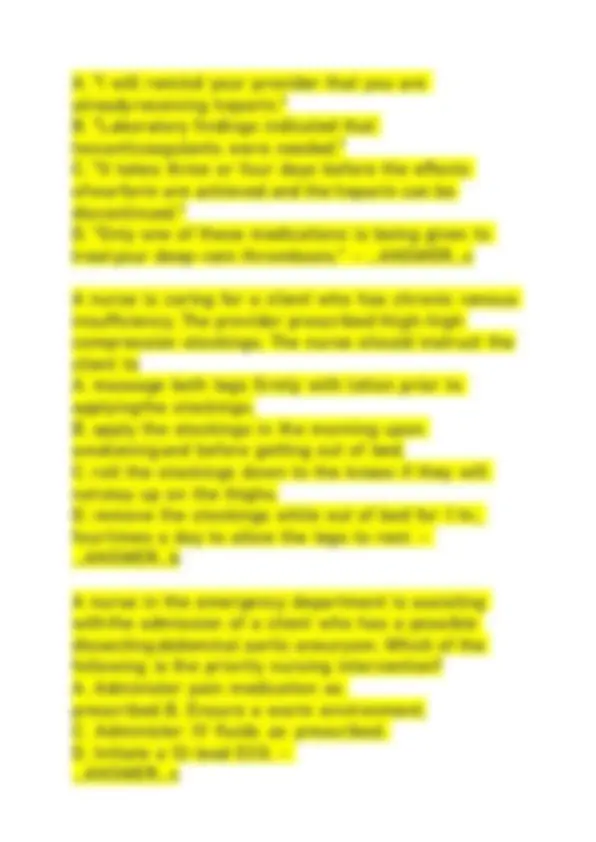
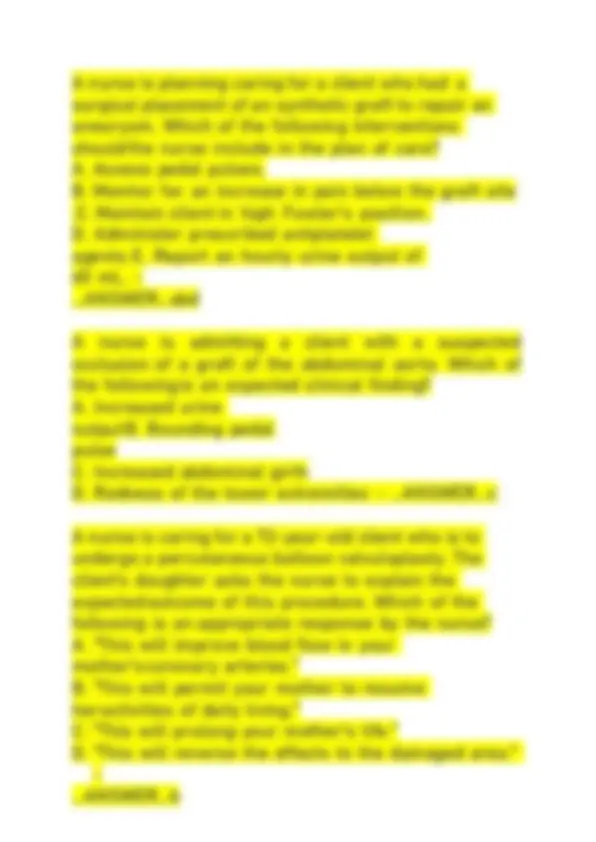
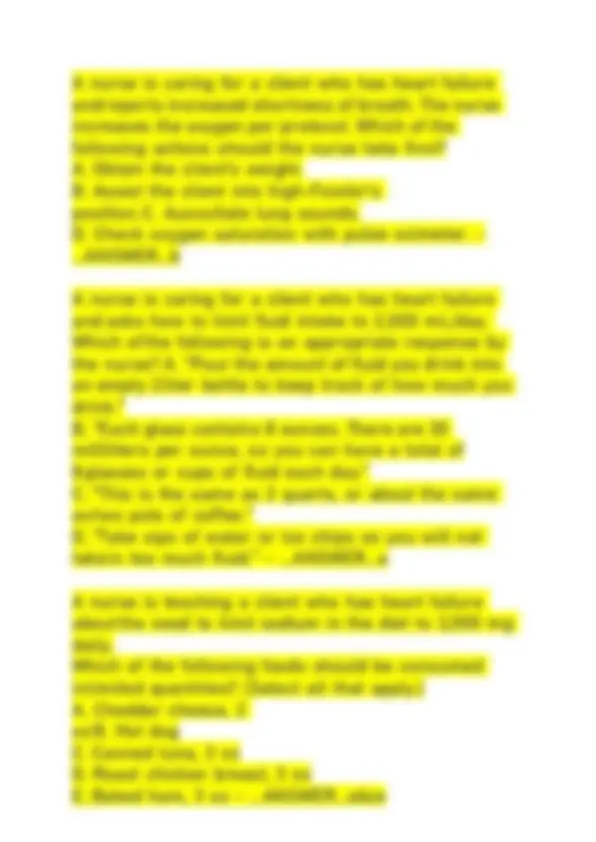
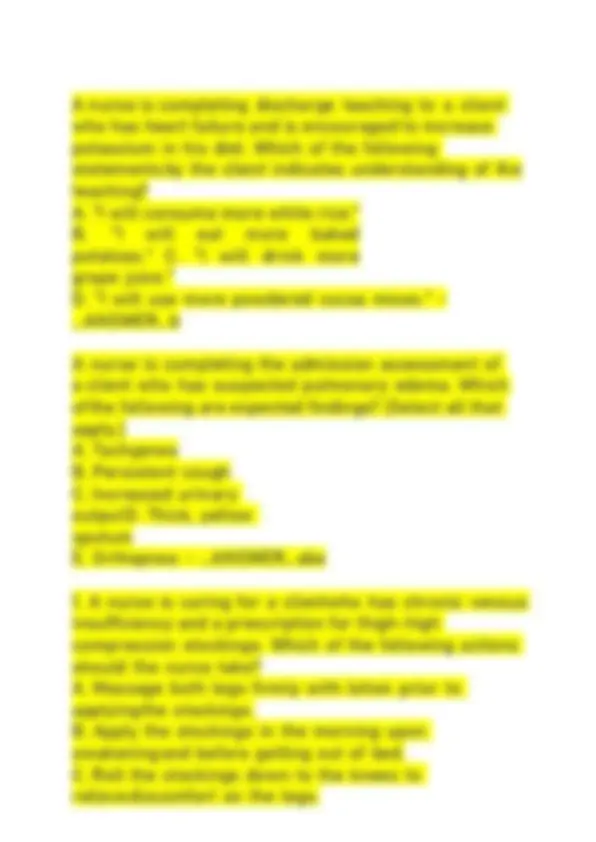
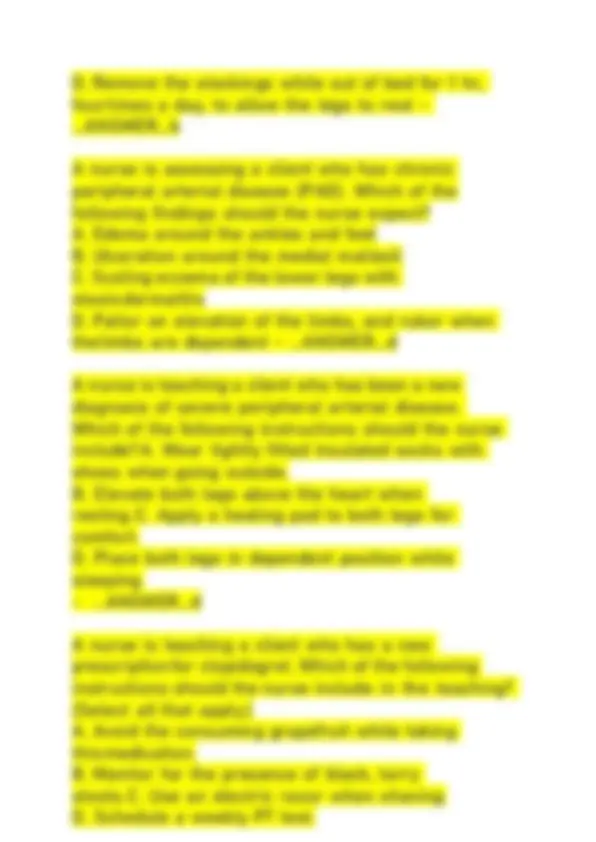

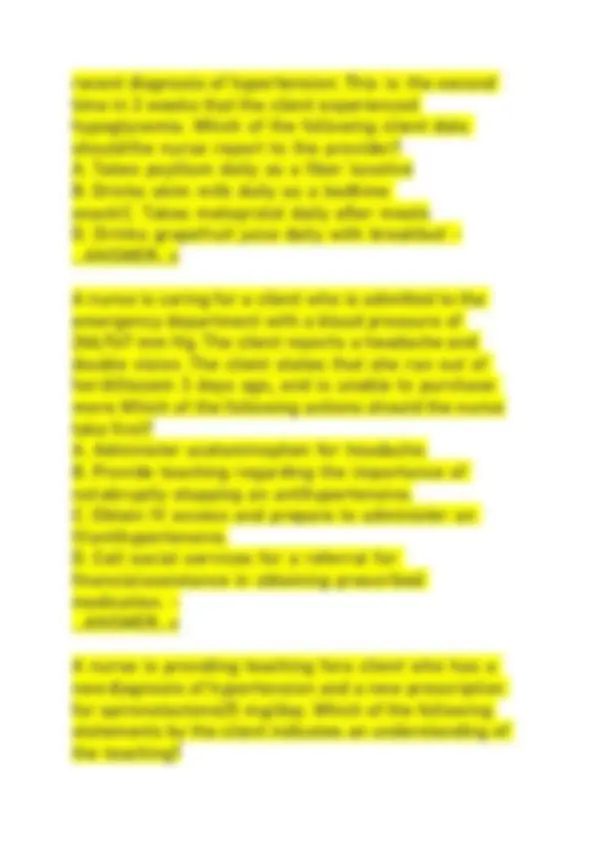
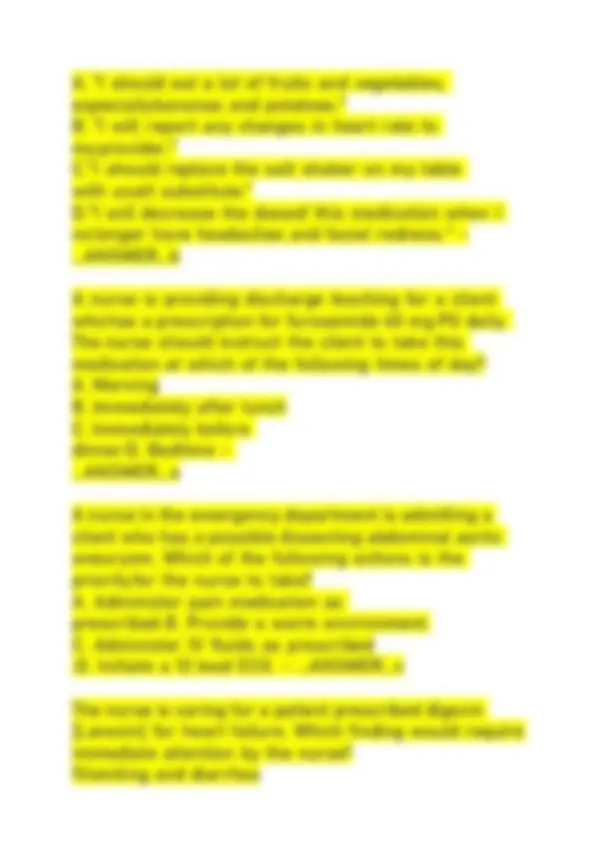
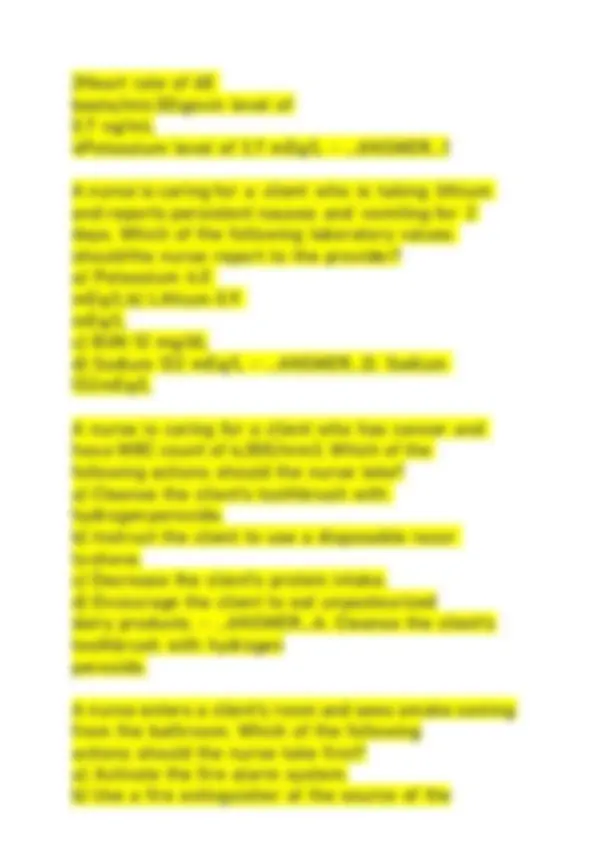
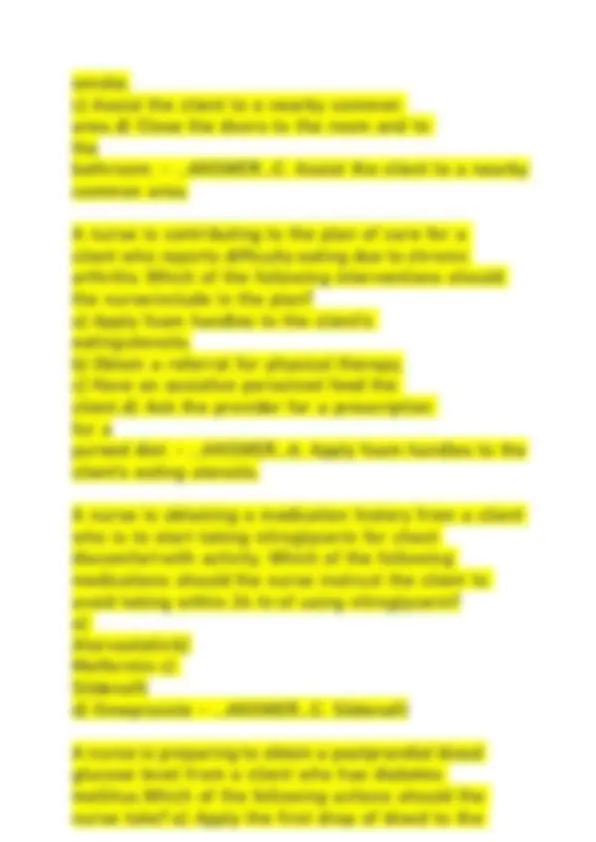
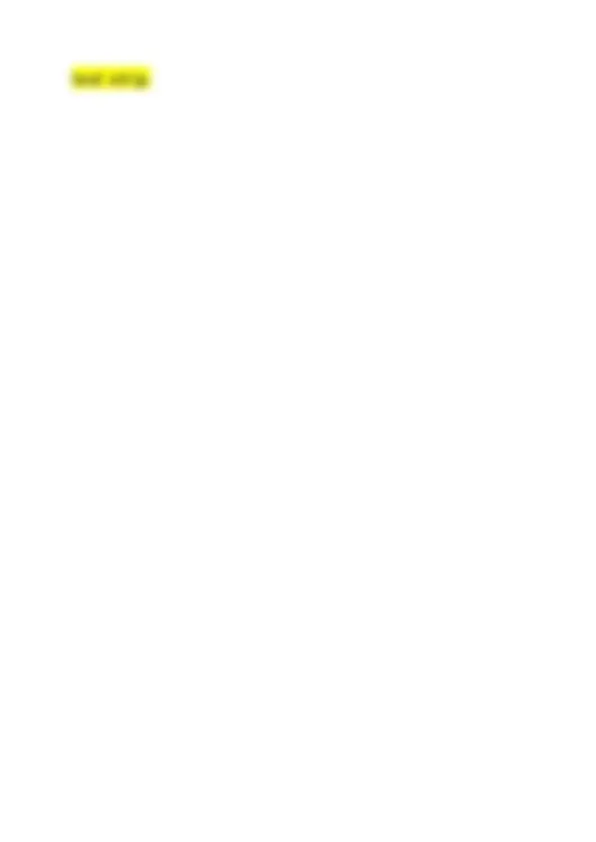
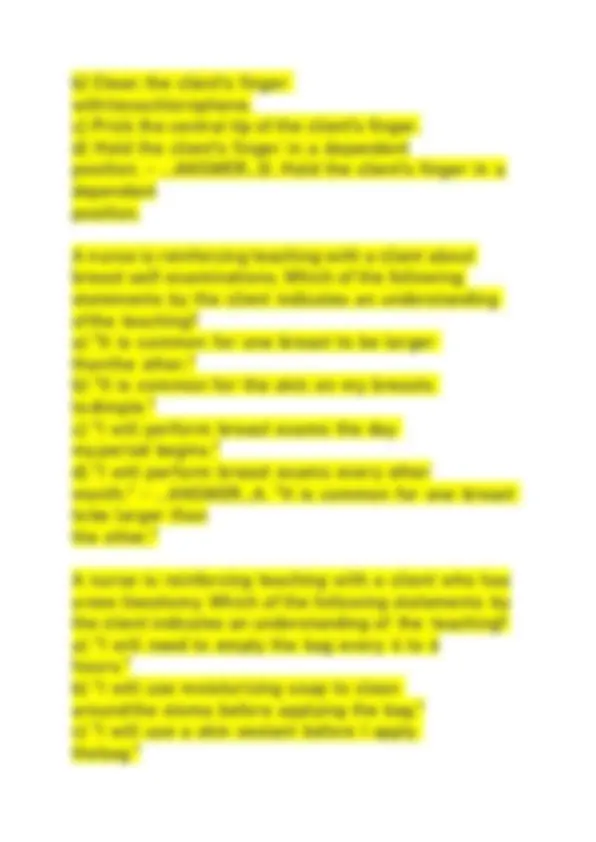
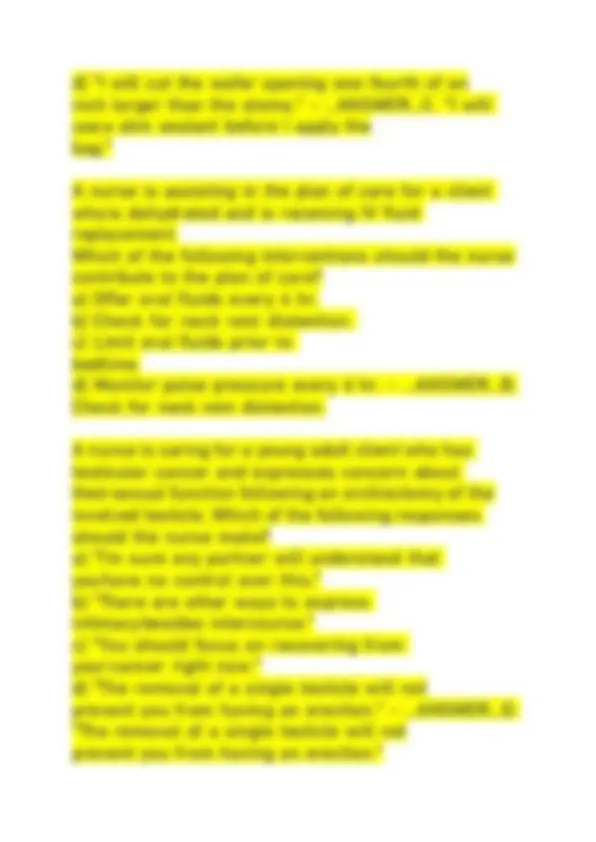
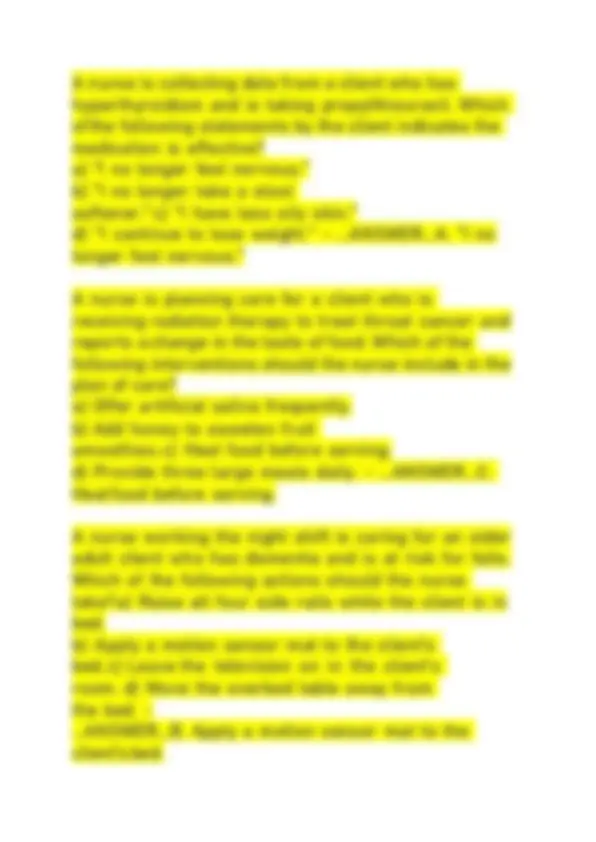
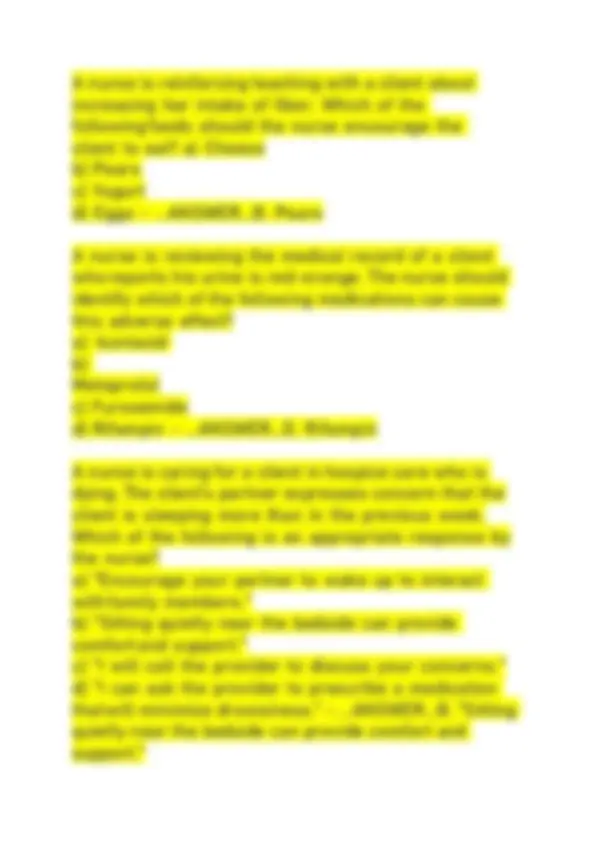
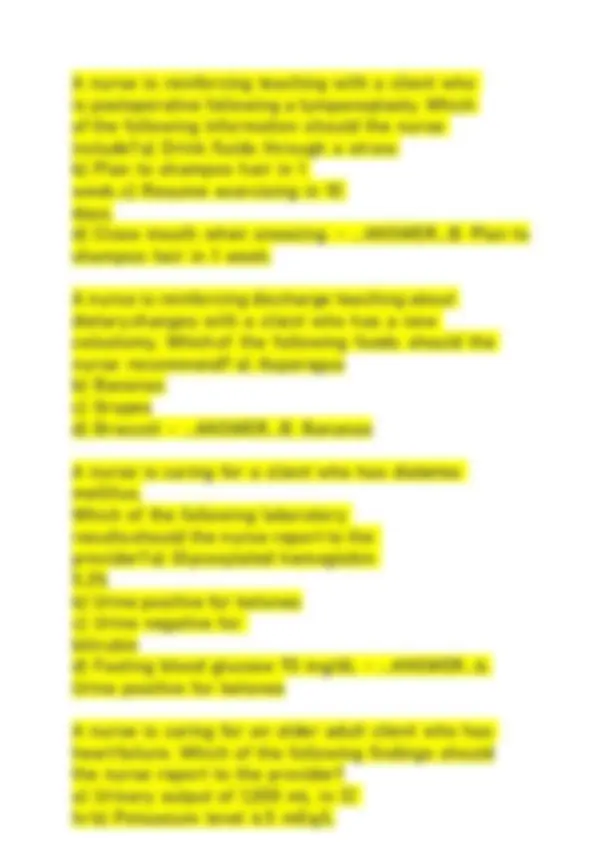
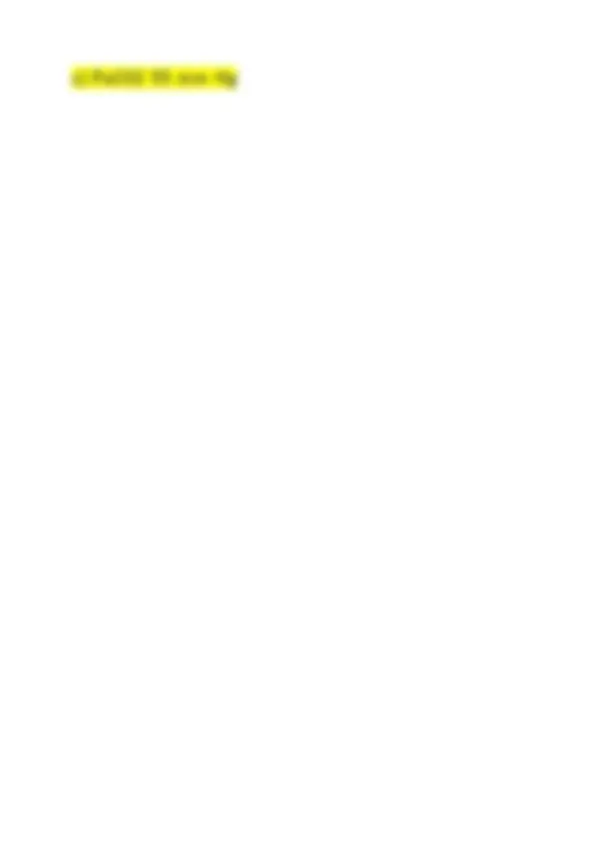
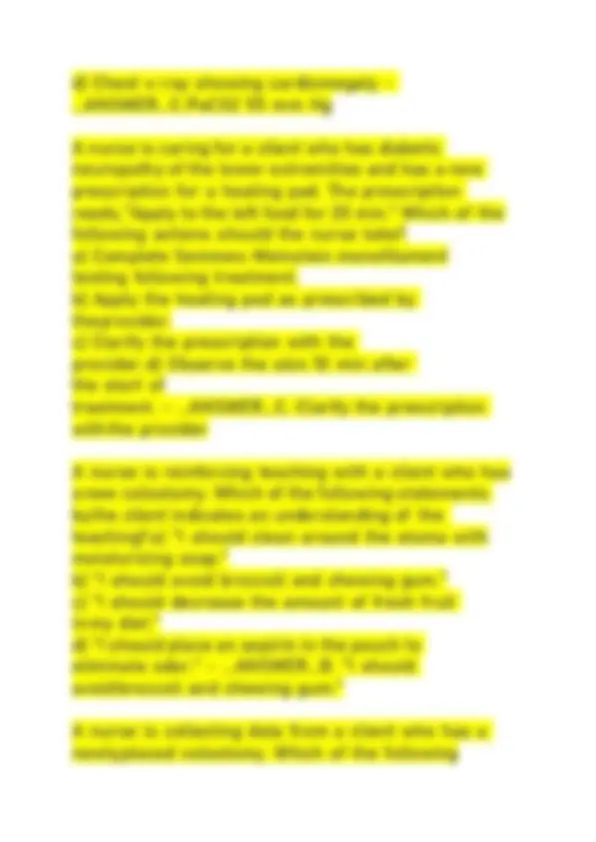
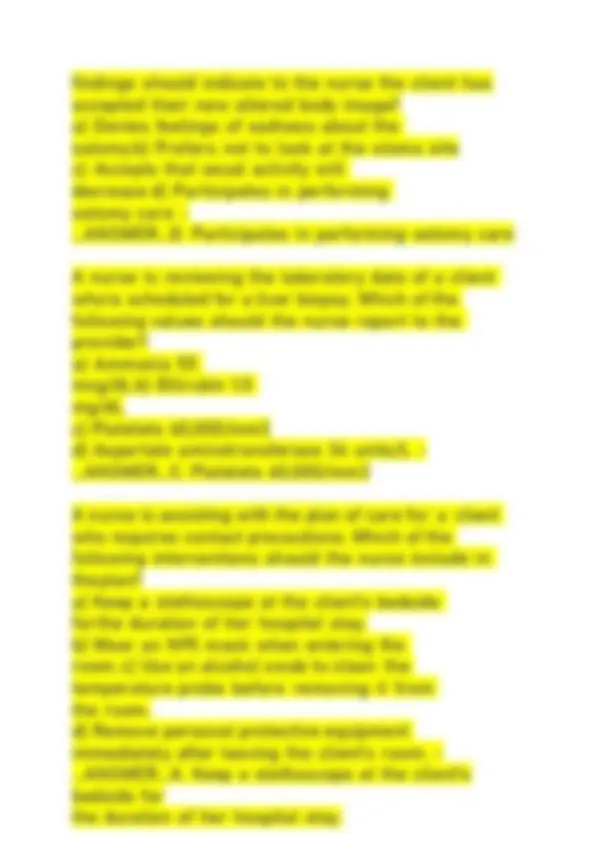
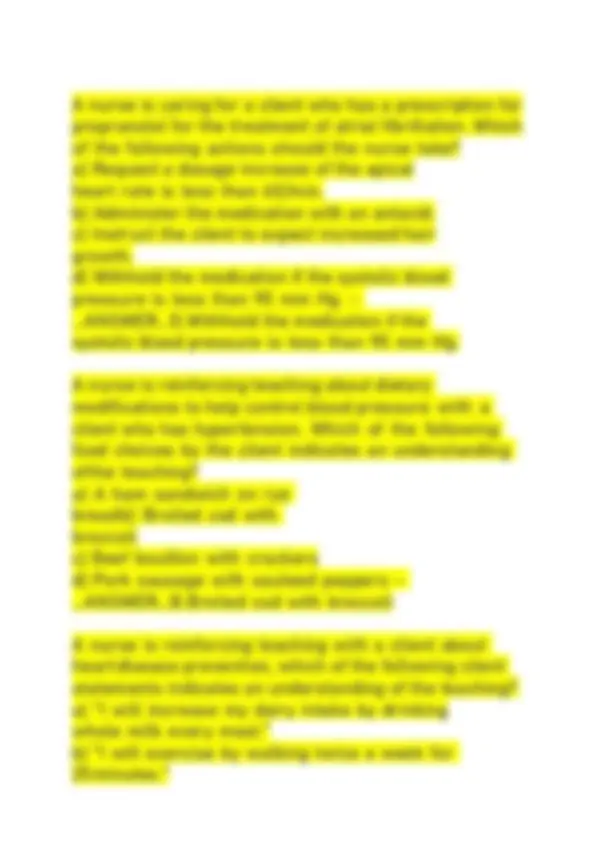
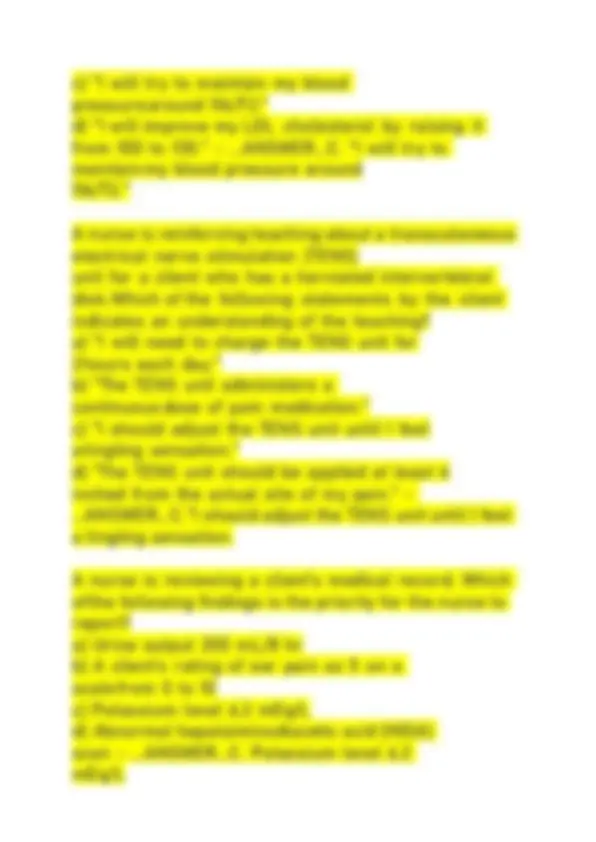


Study with the several resources on Docsity

Earn points by helping other students or get them with a premium plan


Prepare for your exams
Study with the several resources on Docsity

Earn points to download
Earn points by helping other students or get them with a premium plan
Community
Ask the community for help and clear up your study doubts
Discover the best universities in your country according to Docsity users
Free resources
Download our free guides on studying techniques, anxiety management strategies, and thesis advice from Docsity tutors
ATI MEDSURG 2025.pdf graded A+
Typology: Exams
1 / 155

This page cannot be seen from the preview
Don't miss anything!





























































































A nurse is caring for a client who is scheduled for a thoracentesis. Prior to the procedure, which of the following actions should the nurse take? A. Position the client in an upright position, leaning over the bedside table. B. Explain the procedure to the client. C. Obtain ABGs from the client. D. Administer benzocaine spray to the client - ...ANSWER...A. Position the client in an upright position, leaning over the bedside table. A nurse is assessing a client who is in respiratory distress. The nurse should recognize that which of the following can cause a low pulse oximetry reading? (Select all that apply.) A. Nail polish
B. Inadequate peripheral circulation C. Hyperthermia D. Increased Hgb level E. Edema - ...ANSWER.... Nail polish B. Inadequate peripheral circulation E. Edema A nurse is assessing a client following a bronchoscopy. Which of the following findings should the nurse report to the provider? A. Blood-tinged sputum B. Dry, nonproductive cough C. Sore throat D. Bronchospasms - ...ANSWER...D. Bronchospasms A nurse is caring for a client who is scheduled for a thoracentesis. Which of the following supplies should the nurse ensure is in the client's room? (Select all that apply.) A. Oxygen equipment B. Incentive spirometer C. Pulse oximeter D. Sterile dressing E. Suture removal kit - ...ANSWER...A. Oxygen equipment C. Pulse oximeter D. Sterile dressing A nurse is caring for a client following a thoracentesis. Which of the following clinical manifestations
B. Apply sterile gauze to the insertion site. C. Place tape around the insertion site. D. Assess the client's respiratory status. - ...ANSWER...B. Apply sterile gauze to the insertion site. A nurse is assessing a client who has a chest tube and drainage system in place. Which of the following are expected findings? (Select all that apply.) A. Continuous bubbling in the water seal chamber B. Gentle constant bubbling in the suction control chamber C. Rise and fall in the level of water in the water seal chamber with inspiration and expiration D. Exposed sutures without dressing E. Drainage system upright at chest level - ...ANSWER...B. Gentle constant bubbling in the suction control chamber C. Rise and fall in the level of water in the water seal chamber with inspiration and expiration A nurse is assisting a provider with the removal of a chest tube. Which of the following should the nurse instruct the client to do? A. Lie on his left side. B. Use the incentive spirometer. C. Cough at regular intervals. D. Perform the Valsalva maneuver - ...ANSWER...D. Perform the Valsalva maneuver
A nurse is planning care for a client following the insertion of a chest tube and drainage system. Which of the following should be included in the plan of care? (Select all that apply.) A. Encourage the client to cough every 2 hr. B. Check for continuous bubbling in the suction chamber. C. Strip the drainage tubing every 4 hr. D. Clamp the tube once a day. E. Obtain a chest x-ray - ...ANSWER...A. Encourage the client to cough every 2 hr. B. Check for continuous bubbling in the suction chamber. E. Obtain a chest x-ray A nurse is orienting a newly licensed nurse who is caring for a client that is receiving mechanical ventilation, which has been placed on pressure support ventilation (PSV) mode. Which of the following statements by the newly licensed nurse demonstates an understanding of PSV? A. "It keeps the alveoli open and prevents atelectasis." B. "It permits spontaneous ventilation to decrease the work of breathing." C. "It is used with clients who have difficulty weaning from the ventilator." D. "It delivers a preset ventilatory rate and tidal volume to the client." - ...ANSWER...B. "It permits spontaneous ventilation to decrease the work of breathing."
D. Simple face mask - ...ANSWER...B. Venturi mask A nurse is planning care for a client who is receving mechanical ventilation. Which mode of ventilation increases the effort of the client's respiratory muscles? (Select all that apply.) A. Assist-control B. Synchronized intermittent mandatory ventilation C. Continous positive aiway pressure D. Pressure support ventilation E. Independent lung ventilation - ...ANSWER...B. Synchronized intermittent mandatory ventilation C. Continous positive airway pressure D. Pressure support ventilation Which of the following clients have an increased risk for developing pneumonia? (Select all that apply.) A. Client who has dysphagia B. Client who has AIDS C. Client who was vaccinated for pneumococcus and influenza 6 months ago D. Client who is postoperative and has received local anesthesia E. Client who has a closed head injury and is receiving ventilation F. Client who has myasthenia gravis - ...ANSWER...A. Client who has dysphagia B. Client who has AIDS E. Client who has a closed head injury and is receiving ventilation F. Client who has myasthenia gravis
A nurse in a clinic is caring for a client who was brought to the clinic by her partner. The partner states the client woke up this morning, did not recognize him, and did not know where she was. The client reports chills and chest pain that is worse upon inspiration. Which of the following is the priority nursing action? A. Obtain baseline vital signs and oxygen saturation. B. Obtain a sputum culture. C. Obtain a complete history from the client. D. Provide a pneumococcal vaccination. - ...ANSWER...A. Obtain baseline vital signs and oxygen saturation. A nurse is caring for a client who has pneumonia. Assessment findings include temperature 37.8° C (100° F), respirations 30/min, BP 130/76, heart rate 100/min, and SaO2 91% on room air. Using a scale of 1 to 4, with 1 being the highest priority, prioritize the following nursing interventions. A. Administer antibiotics as prescribed. B. Administer oxygen therapy. C. Perform a sputum culture. D. Administer an antipyretic medication to promote client comfort. - ...ANSWER...B. Administer oxygen therapy. C. Perform a sputum culture. A. Administer antibiotics as prescribed. D. Administer an antipyretic medication to promote client comfort.
E. Premature ventricular complexes (PVCs) - ...ANSWER...B. Wheezing C. Retraction of sternal muscles E. Premature ventricular complexes (PVCs) A nurse working on a medical-surgical unit admits a client. Two hours after admission, the client's SaO is 91% and he is exhibiting audible wheezes and use of his accessory muscles. Which of the following medications should the nurse expect to administer? A. Antibiotic B. Beta-blocker C. Antiviral D. Beta2 agonist - ...ANSWER...D. Beta2 agonist A nurse is completing discharge teaching with a client who has a new prescription for prednisone (Deltasone) for asthma. Which of the following client statements indicates a need for further teaching? A. "I will drink plenty of fluids while taking this medication." B. "I will tell the doctor if I have black, tarry stools." C. "I will take my medication on an empty stomach." D. "I will monitor my mouth for canker sores." - ...ANSWER...C. "I will take my medication on an empty stomach." A nurse is assessing a client with asthma. Which of the following is a risk factor associated with this disease? A. Gender B. Environmental allergies C. Alcohol use
D. Race - ...ANSWER...B. Environmental allergies A nurse is reinforcing teaching with a client on the purpose of taking a bronchodilator. Which of the following statements by the client indicates the teaching was effective? A. "This medication can decrease my immune response." B. "I take this medication to prevent asthma attacks." C. "I need to take this medication with food." D. "This medication has a slow onset to treat my symptoms." - ...ANSWER...B. "I take this medication to prevent asthma attacks." A nurse is providing discharge teaching to a client who has COPD and has a new prescription for albuterol (Proventil). Which of the following statements made by the client indicates an understanding of the teaching? A. "This medication can increase my blood sugar levels." B. "This medication can decrease my immune response." C. "I can have an increase in my heart rate while taking this medication." D. "I can have mouth sores while taking this medication." - ...ANSWER...C. "I can have an increase in my heart rate while taking this medication." A nurse is preparing to administer a new prescription prednisone (Deltasone) to a client who has COPD.
B. "When you go out, you can remove the oxygen and then reapply it when you get home." C. "You probably will not be able to go out as much as you used to." D. "Home health services will come to you so you will not need to get out." - ...ANSWER...A. "There are portable oxygen delivery systems that you can take with you." A nurse is planning to instruct a client on how to perform pursed-lip breathing. Which of the following should the nurse include in the plan of care? A. Take quick breaths upon inhalation. B. Place your hand over your stomach. C. Take a deep breath in through your nose. D. Puff your checks upon exhalation - ...ANSWER...C. Take a deep breath in through your nose. A home health nurse is teaching a client who has active tuberculosis. The provider has prescribed the following medication regimen: isoniazid (Nydrazid) 250 mg PO daily, rifampin (Rifadin) 500 mg PO daily, pyrazinamide 750 mg PO daily, and ethambutol (Myambutol) 1 mg PO daily. Which of the following client statements indicate understanding of the teaching? (Select all that apply.) A. "I can substitute one medication for another if I run out because they all fight infection." B. "I will wash my hands each time I cough." C. "I will wear a mask when I am in a public area."
D. "I am glad I don't have to have any more sputum specimens." E. "I don't need to worry where I go once I start taking my medications." - ...ANSWER...B. "I will wash my hands each time I cough." C. "I will wear a mask when I am in a public area." A nurse is teaching a client who has tuberculosis. Which of the following statements should the nurse include in the teaching? A. "You will need continue to take the multimedication regimen for 4 months." B. "You will need to provide sputum samples every 4 weeks to monitor the effectiveness of the medication." C. "You will need to remain hospitalized for treatment." D. "You will need to wear a mask at all times." - ...ANSWER...B. "You will need to provide sputum samples every 4 weeks to monitor the effectiveness of A nurse is caring for a client who has a new diagnosis of tuberculosis and has been placed on a multimedication regimen. Which of the following instructions should the nurse give the client related to the medication ethambutol (Myambutol)? A. "Your urine may turn a dark orange." B. "Watch for a change in the sclera of your eyes." C. "Watch for any changes in vision." D. "Take vitamin B6 daily." - ...ANSWER...C. "Watch for any changes in vision."
C. A client who has a fractured femur E. A client who has chronic atrial fibrillation A nurse is reviewing prescriptions for a client who has acute dyspnea and diaphoresis. The client states that she is anxious because she feels that she cannot get enough air. Vital signs are: heart rate 117/min, respiratory rate 38/min, temperature 38.4° C (101.2° F), and blood pressure 100/54 mm Hg. Which of the following actions is the priority action at this time? A. Notify the provider. B. Administer heparin via IV infusion. C. Administer oxygen therapy. D. Obtain a spiral CT scan. - ...ANSWER...C. Administer oxygen therapy. A nurse is caring for a client who has a new prescription for heparin therapy. Which of the following statements by the client should indicate an immediate concern for the nurse? A. "I am allergic to morphine." B. "I take antacids several times a day." C. "I had a blood clot in my leg several years ago." D. "It hurts to take a deep breath." - ...ANSWER...B. "I take antacids several times a day." A nurse is assessing a client who has a pulmonary embolism. Which of the clinical manifestations should the nurse expect to find? (Select all that apply.) A. Bradypnea B. Pleural friction rub C. Hypertension
D. Petechiae E. Tachycardia - ...ANSWER...B. Pleural friction rub D. Petechiae E. Tachycardia A nurse is caring for a client who is to receive fibrinolytic thrombolytic therapy. Which of the following should the nurse recognize as a contraindication to the therapy? A. Hip arthroplasty 2 weeks ago B. Elevated sedimentation rate C. Incident of exercise-induced asthma 1 week ago D. Elevated platelet count - ...ANSWER...A. Hip arthroplasty 2 weeks ago A nurse is assessing a client who has experienced a gunshot wound. Findings include blood pressure 108/55 mm Hg, heart rate 124/min, respiratory rate 36/min, temperature 38.6° C (101.4° F), and SaO2 95% on oxygen 15 L/min via nonrebreather mask. The client reports dyspnea and pain. The nurse reassesses the client 30 min later. Which of the following should the nurse report to the provider? (Select all that apply.) A. Distended neck veins B. Tracheal deviation C. Headache D. Nausea E. Heart rate 154/min - ...ANSWER...A. Distended neck veins B. Tracheal deviation
A. Bradycardia B. Cyanosis C. Hypotension D. Dyspnea E. Paradoxic chest movement - ...ANSWER...B. Cyanosis C. Hypotension D. Dyspnea E. Paradoxic chest movement A nurse in the emergency department is assessing a client who was in a motor vehicle crash. Findings include absent breath sounds in the left lower lobe with dyspnea, blood pressure 118/68 mm Hg, heart rate 124/min, respiratory rate 38/min, temperature 38.6° C (101.4° F), and SaO2 92% on room air. Which of the following actions should the nurse take first? A. Obtain a chest x-ray. B. Prepare for chest tube insertion. C. Administer oxygen via a high-flow mask. D. Initiate IV access - ...ANSWER...C. Administer oxygen via a high-flow mask. A nurse is orienting a newly licensed nurse on the purpose of administering vecuronium (Norcuron) to a client who has acute respiratory distress syndrome. Which of the following statements by the newly licensed nurse indicates understanding of the teaching? A. "This medication is given to treat infection." B. "This medication is given to facilitate ventilation." C. "This medication is given to decrease inflammation."
D. "This medication is given to reduce anxiety." - ...ANSWER...B. "This medication is given to facilitate ventilation." A nurse is reviewing the health records of five clients. Which of the following clients are at risk for developing acute respiratory distress syndrome (ARDS)? (Select all that apply.) A. A client who experienced a near-drowning incident B. A client following coronary artery bypass graft surgery C. A client who has a hemoglobin of 15.1 mg/dL D. A client who has dysphagia E. A client who experienced a drug overdose - ...ANSWER...A. A client who experienced a near- drowning incident B. A client following coronary artery bypass graft surgery D. A client who has dysphagia E. A client who experienced a drug overdose A nurse is planning care for a client who has severe acute respiratory distress system (SARS). Which of the following should be included in the plan of care for this client? (Select all that apply.) A. Administration of antibiotics B. Providing supplemental oxygen C. Administration of antiviral medications D. Administration of bronchodilators E. Maintaining ventilatory support - ...ANSWER...B. Providing supplemental oxygen D. Administration of bronchodilators